RELATED LINKS
On this page, london bus maps (pdf), public transport london, fares & payments, london airport transfers, cruise port transfers, travel to / from london, most popular tours.

- Guide to hotel areas
- Bed & breakfast
- Backpacker hostels
- Airbnb London
- Central London tours
- Tours from London
- Harry Potter tours
- Stonehenge tours
- Downton Abbey tours
- Windsor tours
- Cotswolds tours
- Private tours
- Ticket & pass offers
- Central London attractions
- Attractions outside London
- Harry Potter attractions
- Tower of London
- PUBLIC TRANSPORT
- London City
- London Southend
- Southampton

London Underground - 2024 fares and how to use them
Be informed and in control using london's underground / metro system.
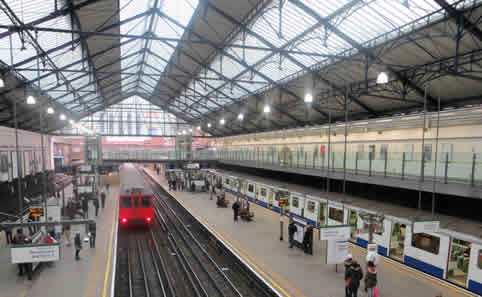
For the visitor to London the Underground or Tube will probably be the transport of choice to get around town. The Underground is normally the fastest way to get around town, often much faster than any taxi.
There is invariably an underground station nearby where you want to go and also your hotel and finding your way around the system is very easy.
There are currently 13 Underground lines, with the Elizabeth Line the latest, which opened in May 2022.
Journey planner Map DLR, overground & TfL Oyster card, contactless & Travelcards Night service Fares Concessions Child fares Group tickets Purchasing tickets Access

Key points about the London Underground
It is still encouraged to wear a facemask when using public transport in London, but it is no longer mandatory.
The authorities penalise you heavily for buying single journey tickets. In the centre you can pay more than double the price than if you used an Oyster Card for example.
A single journey on the London Underground can involve 1 or 2 changes of train. Your journey starts when you go through the ticket barrier of the station entrance you depart from and finishes when you pass through the ticket barrier at the exit of your destination. You cannot break a journey on a single fare, once you go though an exit barrier of a station that is journey completed.
The buses, Underground, DLR and London suburban trains are managed by a central government body called Transport for London (TfL) chaired by the Mayor of London. The transport passes that nearly everyone uses, Oyster and Travelcard, allow you to travel seamlessly across all modes of transport, bus, Underground, train and DLR using the same ticket/pass.
Children under 11 travel free on the London Underground and DLR (Docklands Light Railway) at all times. Child fares are available for those under 16 and it is possible to get discounted fares if you are under 18 or studying in London with an ID card.
There are no seniors fares for visitors. If you reside in London and are over 60 you can get a pass that makes free bus and Underground travel available. If you have an English National Concessionary bus pass you cannot use it on the London Underground (but you can use it on London's red buses).
The London Underground is closed from around midnight until around 5am, getting started a little later on Sundays. However on Friday and Saturday nights, much of the Underground runs through the night. In Central London there is a very good night bus network when the Underground is closed.
You will rarely have to wait more than 5 minutes for an Underground train at any time of the day.
London Journey Planner - for all types of transport across London
Use the TfL (Transport for London) journey planner to plan your travel. The journey planner covers all public transport.
TFL Journey planner

London Underground map
The London Underground map is a classic design that when first launched was immediately taken up worldwide for similar systems. The clarity, simplicity and ease of use compromises strict geographical accuracy.
The Circle line doesn't really go around in a squashed circle and it is not apparent for instance that Bayswater Underground is only 100 yards from Queensway.
In 2016 the Night Tube was introduced. On Friday and Saturday nights only Underground trains run through the night. For lines that operate a night service see the Night Tube map linked below or on the right-menu.
In May 2022 the long awaited Elizabeth Line opened its first section. The Elizabeth Line provides a route connecting East and West London. Find out more about the new Elizabeth Line .
Underground map Tube & rail map Night tube map
Docklands Light Railway (DLR), overground and TfL rail trains
To the east of London in the Docklands region you will see a region covered by something called the DLR (Docklands Light Railway). You can treat this network as just another Underground line.
Not in the centre of London, but in the suburbs you will find a train network called the Overground which can also be thought of as being part of the Underground for ticketing purposes.
Commuter trains into the suburbs are very confusing for the visitor. You can still use Oysters and Travelcards on these but those lines run by the national railways only give free travel to children under 5.
In the north and east of London most of these services are now run by TfL Rail or the Overground so free travel is available to children under 11, but to the south and west of London, services are still dominated by national railways companies.
The Tube and rail map usefully shows which railway stations are in which travel zones. Travel zones are the basis for fare charges on London's railways and Underground system.
London Underground Night Service - the Night Tube
In 2016 the London Underground began to introduce a full 24/7 service on Friday and Saturday nights only. Introduction has been on a phased basis.
Night Tube services are now running on the Central, Victoria, Jubilee line, Northern line (Charing Cross branch) and Piccadilly line (but not Acton to Uxbridge branch). The Night Tube will offer a 24-hour service on Fridays and Saturdays. Standard off-peak fares are levied for travelling on the Night Tube using Oyster and Contactless cards.
Travelcards are valid from the first day of issue (using the date printed on the card), and for journeys starting before 4.30am the following day. For example, if you buy a 1-day Travelcard at 11am on Friday, you can use it until 4.29 on the following Saturday.
Night Tube map - current lines operated
London Underground fares
The London public transport system is divided up into zones that radiate from the centre. Nearly all the hotels and the main sights are in Zone 1. Heathrow Airport is in Zone 6 and the furthest zone out is Zone 9.
The majority of visitors will only travel in the two most central zones 1 and 2. The Underground Map (link above) has the stations and their zones marked.
Some stations, such as Turnham Green, are in two zones. You use whichever zone for these stations is most beneficial in working out your fare.
Underground fares
You can see from the table below there is big financial incentive not to purchase individual tickets and use an Oyster card or Contactless payment card .
The other main way of paying is purchasing a Travelcard , which is a pass giving you unlimited travel for a set time period. The cost goes up with the coverage of zones required. The more zones you require the more expensive the Travelcard.
London Underground Fares from 3 March 2024 - March 2025
Oyster cards, contactless payment cards & travelcards.
As you can see from the above fare structure the authorities do not want you to buy single tickets, they want you to purchase one of the three payment options, Oyster cards, Contactless payment cards or Travelcards.
The Oyster card is a permanent reusable electronic ticket which is topped up from time to time by its owner. Londoners also have their season tickets loaded onto Oyster cards as well and there are passes for one weekly and monthly durations. All can be loaded onto the one electronic Oyster card.
Contactless cards are standard credit or debit cards that support the contactless payment technology, the total cost of all the journeys that you make in one day is calculated at the end of the day and a single charge is made to your Contactless payment card account.
Unlike the Oyster card the contactless facility has a 7-day cap as well as the Oyster daily cap used by Oyster.
You can use Oyster cards on all of London's public transport, not just the Underground, but buses, overground, DLR, suburban rail services and some river services.
Travelcards are another alternatives. Travelcards are valid on the same modes of transport but are unlimited travel passes for a fixed flat fee. Travelcards are available for 1 and 7 days, 1 month and 1 year durations.
You can purchase and subsequently top up Oyster cards and Travelcards from Underground stations and a wide variety of other outlets throughout London including neighbourhood stores, but not Contactless payment cards.
Oyster cards - more details
Contactless payment cards - more details
Travelcards - more details

Seniors concessions
There are no seniors fares for visitors. If you reside in London and are of pensionable age you can get a Freedom pass giving free travel. If you are 60+ and live in London the Seniors Oyster ID Card that makes free bus travel available. You can apply online or get a form from your local Post Office.
Anybody with an English National Concessionary bus pass can use that on London's red buses too and travel free of charge.
If you have a Senior Railcard you can get your 1/3 discount on off-peak Oyster fares. You have to ask a member of staff to load the concession on to a standard Oyster card (note, not a Visitor Oyster card) at an Underground station after showing your Seniors Card.
If you have a Senior Railcard you can also buy a 1 day off-peak zone 1-6 Travelcard at the discount applied.
Child concessions
This is a very complex subject and is covered in detail in the table below. Generally, a child is defined as under 16 years old, but in the last couple of years it has been possible to get child fares after jumping through a few hoops up to the age of 17.
Children under 11 can travel free on the London Underground, DLR and buses without a ticket. If a child is between 11 and 15 years old, you require an Oyster 11-15 Photocard (which has a fee, see below). This allows 11 to 15 year olds to travel at child fares on the Underground, DLR, Overground and some trains, free on the buses.
If you are a short-term visitor (in London for up to 14 days) with kids between 11-15 you can take advantage of the Young Visitor Discount. This means you can get half price fares on an Oyster card on a temporary basis for your child without going through the hoops and expense of getting an Oyster ID card. You do need to read carefully the rules of this scheme though.
Children's Fare Concessions
Group tickets - 1-day group travelcard for groups of 10 or more.
This ticket is for groups of 10 or more travelling together.
This in scope is the same as a 1-day off-peak Travelcard for zones 1-6 and 1-9 providing unlimited travel on all services after 9.30am Monday to Friday and all day Saturday, Sunday and Bank Holidays.
The pricing is particularly attractive if you have kids in the group and those staying in one of the outer zones, however if you are staying in the centre of London zones 1 to 3 it will be cheaper to purchase individual Oyster cards.
If you are a group of 10 or more then do check out this product.

Purchasing tickets & fares levied
There are no longer manned ticket offices at Underground and DLR stations. All tickets are dispensed by ticket machines in the ticket hall and there will be a member of staff hanging around these.
The same machines will allow you to top up your Oyster cards or see what the balance is on your Oyster card and they will also allow you to cancel your Oyster card and get your deposit and any cash left on the Oyster refunded.
If you prefer talking to people selling the tickets there are Oyster ticket stops. These are many of these and typically are convenience stores or news-stands that sell public transport tickets as a sideline. These outlets will have a sign in their front window.
The fare you pay is set by which zone your departure and destination stations are in. Your journey starts when you go through the ticket barrier of the station entrance you depart from and finishes when you pass through the ticket barrier at the exit of your destination. You cannot break a journey on a single fare, once you go though an exit barrier of a station that is your journey completed.
Access to platform & luggage
To gain access to the platforms, and again to exit a station you have to pass through automatic barriers (pictured). There is always one wide ticket barrier for wheelchairs, pushchairs and people with large suitcases.
If you have a single ticket, the barrier at your destination will not return your ticket. There is a manned side gate by the barriers. If you have a Travelcard you insert the Travelcard into the same slot as for the single tickets, the barrier will check that your Travelcard is valid for both date and zones travelled.
If you have an Oyster card or Contactless payment card you swipe the card over a bright yellow pad, the barrier will check validity and will record the station you have started your journey before opening the barrier. The barrier may display the balance on your Oyster too.
At your destination station, exiting through the barrier in effect tells the system you have ended your journey and it works out the fare to be deducted from your card.

BUY VISITOR OYSTER CARD & TRAVELCARD FOR LONDON
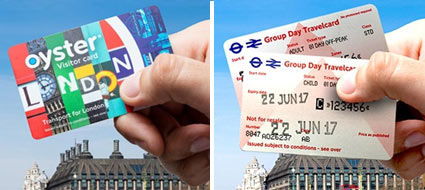
Visiting London? Save time and money on London public transport
• Visitor Oyster Card • Travelcard for 1 day anytime / off-peak or 7 days anytime • Group day travelcards available
LONDON TUBE MAPS (PDF)

London Tube Fares 2024
Transport fares vary depending on when and where you travel, and on the payment method you choose.
Time of the day:
If you travel during peak hours, costs will be more expensive than during off-peak hours. Peak hours are Monday to Friday, between 6:30 am to 9:30 am, and between 4:00 pm to 7:00 pm, except on public holidays.
Ticket type:
- Paper ticket or cash ticket: Single tickets cost between £6.70 and £9.80 .
- Pay-as-you-go (PAYG) or contactless payment methods: By using an Oyster card, which is a prepaid or contactless option, you can save significant money on each journey. For example, if you use it in Zone 1, your ticket will cost less than half the price of a paper ticket. It is worth learning more about this money-saving payment option; see below for more information.
Distance between stations:
When you are in front of the ticket machine, first you must choose the zones you will be travelling through in the next few days. If you are a tourist, you will usually travel within zones 1 and 2. Our suggestion is to select this option because it is where you will find the most famous attractions in London.
Another tip is to add enough credit for 3 days' travel, for example for a family of two adults and two kids: £20 per adult and £10 per child under 15.
Children under 15 are eligible for discounts and free travel. Children aged 5 to 15 pay half the adult fare, while those under 5 travel for free. To access these discounts, ask for assistance at the station; TfL staff will help you.
You must scan your card or ticket at the ticket barrier's reader upon both entering and exiting the Tube platforms.
Oyster Card and Travelcard
When travelling in London, using a prepaid card such as an Oyster Card or Travelcard is the savvy way to go. Not only do these cards offer cheaper fares compared to paying with cash, but they also come with daily spending limits to help you save even more.
The Oyster Card, costing just £5, can be ordered online and sent directly to your home before you arrive in London. Once you have it, you can top it up with as much credit as you need. This credit doesn't expire – it's yours to use whenever you're in London. Travel on the Tube, buses, and other TfL services becomes more cost-effective, thanks to the daily caps on spending. For example, if you hit the daily cap of £8.50 with an Oyster Card, you won't pay a penny more for any additional trips that day.
Remember, if you don't use all your credit, you can easily get a refund for up to £10 at any ticket machine – although the initial £5 cost for the card itself isn't refundable. The card is reusable for your next visit, though!
And if you prefer to travel light, you can tap in with a contactless bank card. Just keep an eye on any potential bank charges. Similar to the Oyster or Travelcard, contactless bank cards also benefit from a daily cap on charges, ensuring you don’t spend more than a set amount each day, regardless of how many trips you make.
Here are the tables that outline the fare caps and Travelcard prices:
Pay as you go (PAYG) caps: For trips on the Tube, DLR, London Overground, TfL Rail, and National Rail, there are daily and weekly spending caps that apply.
Travelcards: These cards give you unlimited travel within the chosen zones and are available for different lengths of time.
We highly recommend using a card when travelling around London – it's cheaper than cash and caps your daily spend. Grab an Oyster Card or a Travelcard for just £5. They're both prepaid, which means you can add money to them and only pay for the travel you use.
Before you come to London, you can buy an Oyster Card online and have it sent to your home. It's a durable card that never expires, ready for your next London adventure.
In addition to the Oyster Card, the Travelcard is an excellent option for those planning to make extensive use of public transport. You can purchase a Travelcard for periods of 7 days, a month, or even a year, making it ideal for regular visitors or residents of London. Unlike the Oyster Card, which charges per trip up to a daily cap, the Travelcard allows you unlimited travel within the zones you have selected, without concern for the number of trips you make.
For added convenience, both the Oyster Card and Travelcard can be topped up online, at ticket vending machines, or at any London train or Tube station. With these cards, you can fully enjoy all that London has to offer, moving around the city efficiently and cost-effectively.
Where to buy tourist tickets online?
Questions and answers.
Where can I buy tickets to travel on public transport in London?
- Tickets and prepaid card top-ups can be purchased at the ticket machines that can be found at the Tube stations. You can pay by credit/debit card or in cash (coins or notes). Ticket vending machines are available in different languages.
How much do young children pay on London transport?
- Children under 5 travel free with a fare paying adult.
- Children aged 5 to 10 travel free on buses and trams with an Oyster card, no ticket needed.
- Children aged 11 to 15 can receive the following benefit through an Oyster card: 50% off adult-rate pay-as-you-go fares and daily caps on a bus, Tube, tram, DLR, London Overground, Elizabeth line, National Rail services, and London Cable Car.
For more information on discounts, visit the official transport website . Tourists should note that the Oyster Card can be bought online before travelling to London and be delivered to their home address. The card costs £5. Then you decide how much credit you want to top it up with. This prepaid card has no expiry date.
Where can I find precise information for the rest of the fares and tickets?
- You can find detailed information on all fares and tickets in the official announcement regarding the March 2024 prices, available at this link: www.london.gov.uk/media/104143/download .
If you notice any errors on this website or have any suggestions, please use our contact form , and we will try to solve the problem as soon as possible.
Thank you for visiting our London Tube fares page, we hope you found it useful.
London tube map | Timetable | Fares | All tube lines
Bus & Tram Journeys Multiple bus rides made in a one hour period count as a single bus journey.
Tube & train journeys.
Your fare is
JavaScript is disabled
Please enable JavaScript in your browser in order to use OysterCalculator.
This website uses cookies to improve your browsing experience and analyze the use of the website. Learn More
Reserve Your Spot with Confidence! Full Refunds with 24 Hrs Notice. Reschedule at any point, even after tour, if space allows!

How to Use the London Underground

Similar to the New York Subway or the Paris Metro, the London Underground is London's series of (largely) underground trains that run a regular service throughout the city.
Since the trains underground run through a series of tunnels, many people (Londoners and visitors alike!) refer to it as the "tube."
Despite this name, a lot of the London Underground network is above ground when you travel, particularly outside of central London.

The London Underground has 11 lines that serve Greater London, intersecting with each other in the centre of town.
The tube map is divided into nine zones, with Zone 1 being the centre of London, and Zone 9 being the suburbs.
The cost it takes to travel depends on which zone(s) you travel in, and how far your journey will take you.
It also connects to the London Overground (a suburban train line that doesn't run through the centre of town), the new Elizabeth Line (a high-frequency rail service that covers both central London, Heathrow Airport, and the suburbs), and National Rail Services (standard train lines that run throughout the country).
The Underground also connects to other rail services that serve the capital such as the Docklands Light Railway (an aboveground small train line that serves the docklands area).
WHEN DOES THE UNDERGROUND RUN?
In general, the Underground trains run from around 5:00 - 5:30 am until the last train leaves around Midnight, (exact times will vary and are listed on the Transport for London website ).
However, there are Night Tube services that run on some of the lines on Fridays and Saturdays for convenient travel on the weekends.
The Night Tube runs on parts of the Central, Jubilee, Northern, Piccadilly, and Victoria lines only.
- Tickets, Fares, and Oyster Cards
- The Tube Map
- Operating Hours
- Tips from Locals
- to/from Heathrow Airport
- Tourist Buses vs. the Tube
LONDON UNDERGROUND TICKETS AND OYSTER CARDS
Buying a ticket for the London Underground is pretty straightforward, but for most visitors, using a contactless payment card is the best payment method.
So, for a more in-depth explanation, including the cheapest ways to travel, check out our previous post about ticket prices and options here in London. Below is our summary.
There are 4 ways to pay for your rides on the Tube:
- Paper tickets
- Oyster Cards
- Contactless Credit/Debit Cards
We normally recommend avoiding paper tickets and recommend that you buy yourself an Oyster card, unless you have a contactless credit or debit card.
Rides with an Oyster Card or contactless card are much cheaper than paper tickets.
You can add as much money to these as you wish and there is a daily limit that you will spend, (£8.10 for Zones 1-2) so the rides get cheaper the more you use them. The same daily cap applies to your contactless card, too.
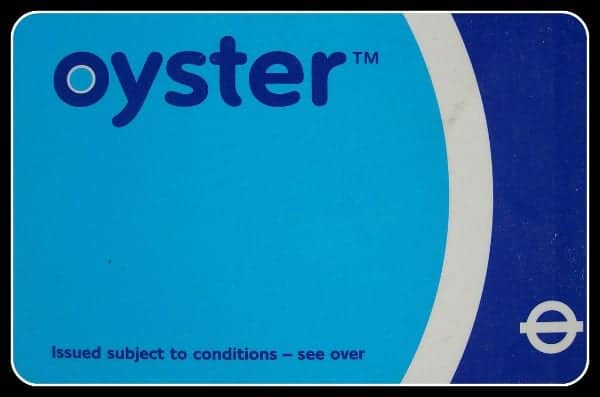
Read our post on which London Oyster Card or Travelcard to buy .
TIP: The Oyster Card is actually included with the London Turbo Pass at no extra cost. If you're planning to visit several notable attractions in the city, this could be a great way to save some money.
London Underground Fares
While there are 6 travel zones for the London Underground, most visitors to London will travel largely within Zones 1 + 2.
How much you pay depends on when you travel, whether during peak hours (06:30 - 09:30 and 16:00 - 19:00 Mon-Fri) vs. off-peak (all other times).
It also depends on where you travel to and from, and whether you are using a paper ticket vs. an Oyster, Travelcard, or contactless credit/debit card.
If you have one of the latter, then you will pay somewhere between £2.70 and £3.00 per ride within Zones 1 + 2.
The most expensive ride (Central London to Heathrow) will cost either £3.30 (off-peak) or £5.60 (peak).
Oyster and Travelcards can be used on all of London's public transportation options, including buses, DLR, the Overground, suburban trains (within London), a water taxi, and even a gondola.
Daily Limits
If you use an Oyster Card or a Contactless Card, then there are daily limits to what you will spend. These caps are dependent on where you are traveling within.
So, for example, if you stay within Zones 1 and 2, the cap for an adult is just £8.10 for the Underground and £5.25 for buses.
So, the more you ride, the cheaper each ride is. You can see what the cap is for each zone or between zones here.
Child Offers
Children under 11 travel for free and there is a 50% off on Oyster Card fares for children 11-15 years of age.
To receive this offer, you need to grab a Tube staff member at any Underground station, including Heathrow.
We help you determine which type of card or ticket you need in our in-depth post on Oyster Cards .
Travelcards
Travelcards are prepaid cards that give you unlimited access to specific zones within London.
You can choose to either order these in advance (in which case you will be given a paper Travelcard) or you can buy them upon arrival (in which case you will be using a plastic Oyster Card with the Travel Card loaded onto it).
Travelcards particularly have benefits for travellers here for an entire week. A 7-Day Travelcard can be worth your while, as a 7-Day Travelcard for Zones 1-2 is £40.70 which works out less per day than the £8.10 daily cap.
Find out more on our post comparing Oyster Cards, Visitor Oyster Cards and Travelcards .
UNDERSTANDING THE TUBE MAP
Picking up a Tube map is easy! They are available for free at most stations on the Underground network.
The maps on offer at the stations are small – perfect for carrying around in your pocket.
Below is a map of the London Underground. You could also download a PDF version .

Don’t be embarrassed to consult your map as you travel through London, even Londoners themselves occasionally need to check where it is they are heading to!
Some people will actually have an app on their phone sporting the London Underground tube map – though we think Google Maps App is very good.
If you look closely at the map, you will notice that the center part is shaded white (zone 1) with a ring of gray shade (zone 2) which is also surrounded by white again (zone 3).
Again, most visitors to London will spend much, if not all, of their time in Zones 1-2.
Focus on Colours
Every line on the London Underground has a different name and colour.
The names and colours will appear on your Tube Map, and also all over the various stations on the network.
For some, memorising the names is easier, but in general, colours can be the simplest way to learn your way around, and also to use when asking for/receiving directions.
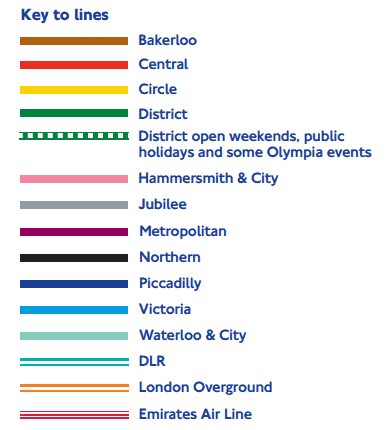
Generally speaking, any particular line will either head north-south or east-west.
FREE TOURS BY FOOT TIP:
Start your holiday in London with our All-in-One London Tour, which takes in most of London's legendary tourist sites and utilizes the London Underground. Get a tutorial directly from us.
OPERATING HOURS AND THE NIGHT TUBE
It’s important to remember that the London Underground system doesn’t run 24 hours a day every day and that timings may be different on weekdays vs. weekends.
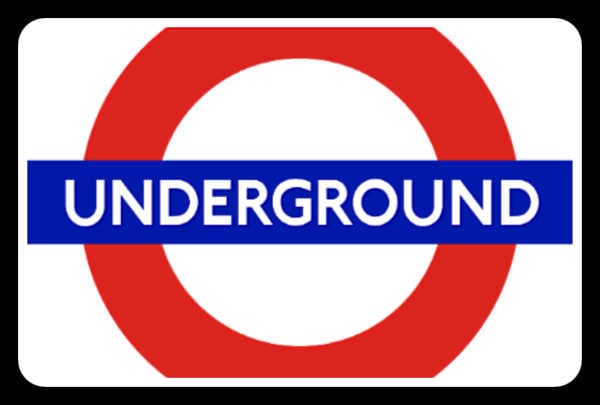
General Hours
Although each station has different timings, in general, the first tube trains start running around 5:00 am - 5:15 am and finish around 12:00 am - 12:30 am from Mondays through Fridays.
On Sundays, the Tube begins a bit later, around 6:00 am - 6:15 am and the final trains depart around 11:30 pm - 12:30 am.
Sundays also carry a reduced service which means there are not as many trains running as on Mondays to Saturdays.
Weekdays: 7:00 am - 9:30 am and 16:00 (4 pm) - 19:00 (7 pm).
Like any major city, London has a very busy rush hour in the mornings and in the evenings when the majority of people are travelling to and from work.
If possible, try to avoid travelling on the tube during these times, particularly if you have any large baggage/luggage with you.
Space is an absolute premium, which means you may have to wait as multiple trains pass you until there’s one with enough space to fit you in.
If you need a place to store luggage, read our advice here.
The Night Tube
As of 2019, some London Underground lines are now operating as The Night Tube, a 24-hour Underground service that operates on Fridays and Saturdays.
Really, this service should be called the "Overnight Tube" as the regular operating hours reach midnight every day of the week.
Click here for a downloadable pdf .

There are 5 lines making up the Night Tube and there are fewer trains operating, which means wait times are more than the standard 2 - 5 minutes.
The lines and approximate timings are:
- Victoria Line - Trains every 10 minutes
- Jubilee Line - Trains every 10 minutes
- Piccadilly Line (Cockfosters to Heathrow Terminal 5 ONLY) - Trains every 10 minutes
- Northern Line (Camden Town to Morden) - Trains every 8 minutes
- Northern Line (Camden Town to High Barnet) - Trains every 15 minutes (No Night Tube on the Bank and Mill Hill East Branches)
- Central Line (White City to Leytonstone) - Trains every 10 minutes
- Central Line (Leytonstone to Loughton/Hainault) - Trains every 20 minutes
- Central Line (Ealing Broadway to White City) - Trains every 20 minutes (No Night Tube on other branches of the line)
NOTE: The Night Tube operates with standard off-peak fare prices. Your daily travel card will be valid until 4:29 am the morning after you have purchased it.
TIPS ON NAVIGATING THE UNDERGROUND
Now we will provide you with our top 7 tips for navigating your way through the system, from how to enter a system, how to board the correct train, how to change lines, and when to walk instead of taking the Tube.
Underground Tutorial Tours
Let us, Free Tours by Foot , show you how to utilize the London Underground to get around the city - like our London in a Day or our Harry Potter Tour .

While these are not specifically Underground tours, your tour guide will assist you in learning how to master the system and to offer you some tips and tricks for riding the Tube.
1. Entering and Exiting Stations
All Underground stations have ticket barriers – large grey machines where travellers either insert their paper travel cards or tap their Oyster cards on top of them.
At first glance, most barriers all seem the same but they are actually divided into three different purposes; Enter, Do Not Enter, Bags/Buggies.

Some of the barriers will have a green arrow displayed – this means this is a barrier that you can travel through.
Insert your paper ticket, or tap your Oystercard on the yellow pad right next to the sign displaying the green arrow.
The barriers in front of you (just left from the arrow) will open and allow you to walk through.
Other barriers will have a red X displayed – this means this barrier will not open for you and is either closed or being used for visitors traveling in the opposite direction.
Lastly, some barriers are quite large, with signs displaying buggies, luggage, and wheelchairs.
These barriers are much larger than the regular grey ones and are there for people travelling with added items/persons.
They will not close as quickly as the others, giving travellers time to get themselves and all possessions through to the other side.
Read our post on taking the Tube from Heathrow Airport to Central London .
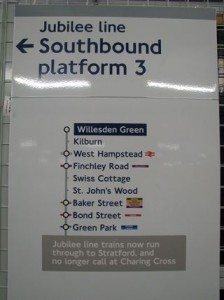
2. Find Your Correct Direction
In general, the Underground lines operate going north-south or east-west and vice versa.
Checking on your map will help you determine which direction you are travelling in, which will help you find the correct platform and train for your journey.
At every station, there will be maps like these showing the two directions that the trains will be travelling in, and under each direction will be a list of all the stations the train will stop at – in order!
This makes it easy not only to see which platform you need to be on but also how many stops it will take you to get to your destination.
3. Don't Board the Wrong Train
Sometimes, multiple Underground lines share the same track at a station. If you aren't paying attention, you could board the wrong train.
As the trains pull into the platform, you can take a glance at the front of the train. Here will be displayed the final destination of that particular train.
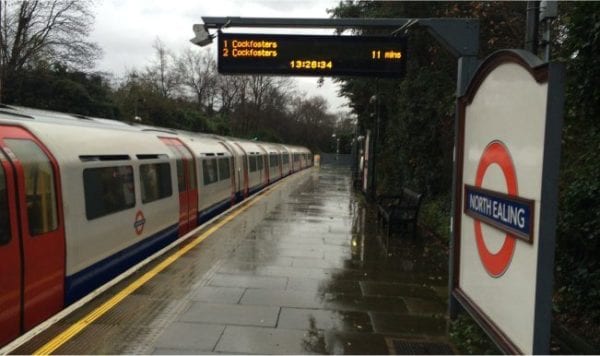
Also, on every platform there will be an electronic sign displaying the time until the next train arrives, and which station will be its’ final stop.
4. Lines that Split
Another potential mixup is lines that split. Some lines can have 2 or 3 different ending tracks, so you need to be aware of this.
Take the image below as an example.
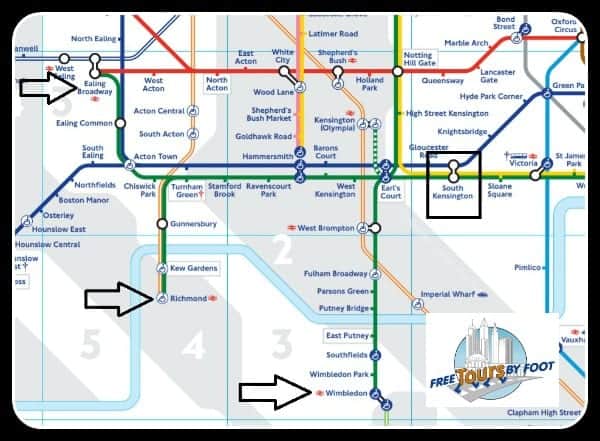
For example, suppose you plan on boarding a District Line (green) train at South Kensington Station (the black square) with a final destination Wimbledon (the bottom-most black arrow).
You would be taking a westbound train.
However, you can see from the map that there are two additional tracks with different ending points (Richmond and Ealing Broadway), all a part of the District Line heading westbound.
As you probably can tell, you could end up missing the first tennis match.
5. Changing Lines
The Tube map can often be misleading in that many tube lines crisscross over each other on the map, but do not actually connect to one another in reality.
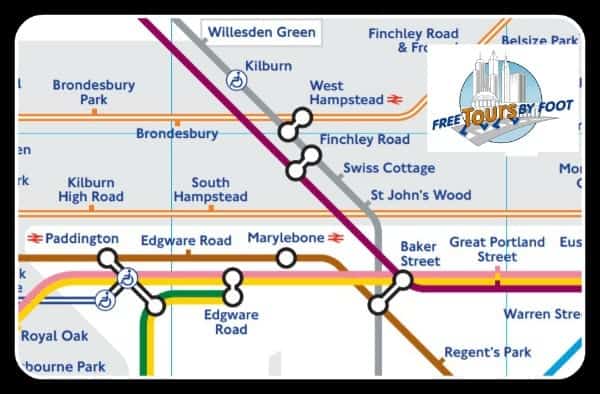
If you want to know where you can change from one Tube line to the other, you need to look for the white circle on the line on your map.
Any time you see one of these, it means you can change from one line to another or to British Rail.
Check out our tips on using the Underground with luggage and kids .
6. Sometimes You Should Just Walk
The London Underground Map is definitely NOT geographically accurate. Oftentimes it is easier to walk instead of getting on the tube to travel just a stop or two.
There is a map that gives the walking times between stations ( pdf ).
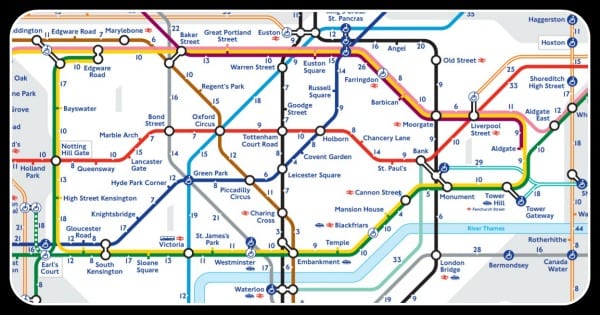
A good example of this is Leicester Square and Covent Garden on the Piccadilly Line.
On the map, they appear a fair distance apart, but in reality, it would take you just 4 minutes to walk the journey yourself.
Another good example is Charing Cross and Embankment - it’s just a 2-minute walk from each station!
7. Step-Free (Handicap) Access
For those with limited mobility, there are clues on the Underground map that will let you know if there is step-free access.
This is also useful if you are travelling with exceptionally heavy suitcases.
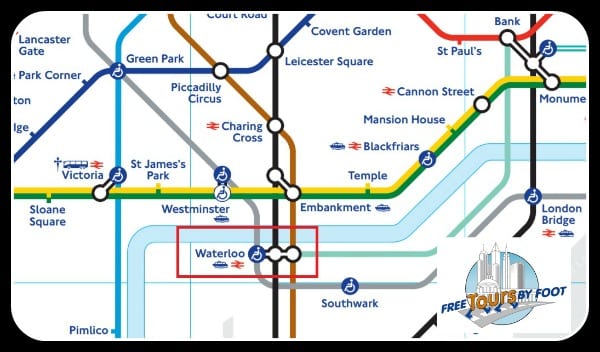
Simply look at the map, and on some stations, you will see a blue circle with a white figure in a wheelchair.
This means it is possible to get from the street into the train without any stairs or escalators.

The white circle and a blue figure in a wheelchair denote stations with step-free access from the street to the platform.
At these stations, you will need assistance to get into and out of the train, either with a ramp or the help of fellow passengers.
Note that in larger stations, such as Waterloo, the blue circle appears on one line only, which means the other two lines do not have step-free access. Transport for London has this helpful video .
A final note – Although London is generally a safe and welcoming city for visitors, pickpockets, and thieves operate throughout the entire London Underground network.
Please be aware of your surroundings, keep hold of all of your possessions, and avoid the habit of simply putting your ticket/credit cards/keys/mobile phones into your pockets – this will make you an incredibly easy target!
Also, never leave your belongings unattended on a train or in an Underground Station.
PICADILLY LINE TO AND FROM HEATHROW
By far the easiest and most affordable way to get to and from Heathrow Airport.
The Piccadilly Line runs through all 5 terminals of Heathrow Airport as well as straight through the centre of London, offering connections with every other tube line on the London Underground network.
Use our Google Map and input the address of your final destination for directions and travel time from Heathrow .
Travel time on the Tube is roughly 45 minutes to central London.
Piccadilly line trains run out of Heathrow from 5:00 to 23:00.
Ticket prices from Zone 1 to Heathrow are £6.70 for a cash-bought paper ticket, £5.60 on an Oyster card or contactless card at any time.
Read our full post on taking the Picadilly Line to and from Heathrow Airport .
TUBE ETIQUETTE
To avoid faux pas and keep from being marked out as a typical tourist, here are a few tips for Tube etiquette when travelling along the Tube.
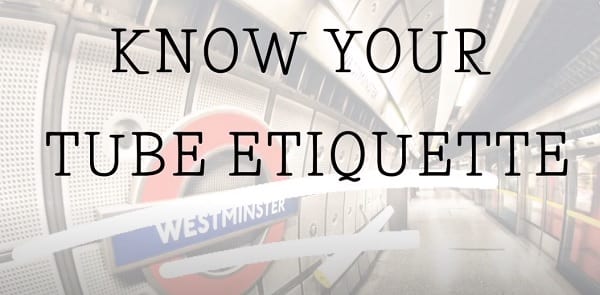
1. Have Your Ticket Ready
Do not approach the ticket barriers until you have your Oystercard – or paper ticket – ready.
If you walk to the barrier and then fumble through your pockets/bags for your ticket, it will delay other travellers and oftentimes can mess with the barrier censors, potentially causing the barriers to lock.
[Remember you need a ticket both to BEGIN/ENTER and also to FINISH/LEAVE your journey!] Be sure to read our blog post on the Oystercard and Travel Card .
2. Stand on the Right
When riding escalators up and down in Underground Stations, please remember to stand on the RIGHT.
Travellers who wish to move up/down whilst on the escalators will be doing so on the left-hand side.
If you stand on the left you may find yourself politely asked to move to the right, or simply shoved past by a multitude of commuters.
This also includes your belongings/suitcases – they must be on the right of the escalators as well.
It is poor form and bad manners to take up the left side of the escalator with your belongings.
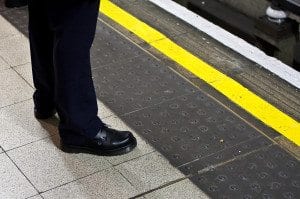
3. Stand Behind the Yellow Line
On every Tube platform, you will find a yellow line painted along the edge.
This line marks the boundary between where it is safe to stand, and where it is dangerous.
Stand BEHIND the line (not on top of!) in order to limit any risk of death or injury.
You may occasionally see passengers swiftly walking down the platform directly on top of the yellow line – but do not follow their lead!
4. Move Down the Platform
As soon as you get onto the platform, move either right or left.
You will find many people gathered at the entrance to the platform, meaning people cannot get past them and move onto the platform to get their train.
TIP : Besides just being courteous, the rear and front of the trains tend to be less crowded so moving down the platform means you’re more likely to get a seat!
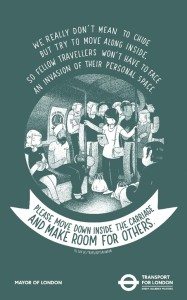
5. Let Other Passengers Off First
As soon as the Tube doors open, step to either side of the opening doors and let customers off the train before you attempt to board.
Failure to follow this rule may lead to verbal chastisement.
6. Move Down Inside the Carriage
Once you are inside the Tube – move away from the door! Standing in place will impede others who are trying to board.
Also (especially during peak times) it is important to move as far down into the carriage as possible in order for the maximum amount of people to fit onto the train.
You will see Londoners standing in between the benches on busy Tube carriages, and you should follow their lead.

7. Keep Feet and Bags Off the Seats
Particularly on crowded trains, it is unacceptable to take up an entire seat solely for your possessions – or your feet!
8. Do Not Lean on the Poles
The poles that are placed throughout the Underground train carriages are meant for people to hold on to.
Leaning against one of the poles means blocking the pole for those that may need it to hold balance whilst the train is moving.
9. Mind Your Earphones and Your Meals
The music you are listening to should not be loud enough for anybody else on the Tube to hear.
Also, it is best to avoid eating hot/smelly food on the Underground.
10. Get Out of the Way of Those Getting Off the Train
When you are on the Tube and at a stop that is not yours, make sure you are not in the way of those who are trying to exit the train.
Occasionally, you may need to step outside of the train to let passengers off if the carriage is very crowded.
This is expected behaviour, and you will be able to step right back on once the departing have left.
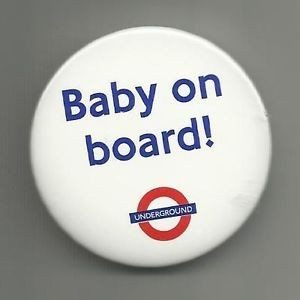
11. Stand Up for the Elderly and Pregnant
This is one even some Underground regulars need reminding of!
It’s just good manners in the UK to offer up your seat to the elderly, pregnant, or those who are less able to stand.
Be aware of who comes on the Tube at each stop and do not be afraid to offer your seat.
Occasionally you may see women with a small ‘Baby on Board’ badge with the London Underground logo pinned onto their coats.
Some men even take it upon themselves to stand up for any woman who comes onto the train so chivalry is not completely dead in London!
12. Take Your Rubbish Home With You
Rubbish left behind on the Tube is unsightly and can be quite disgusting.
There are no bins on Underground trains or at most Underground Stations which means it is expected that you will take any rubbish of yours off the train and home/back to your hotel with you when you leave.
On the London Underground, a little bit of courtesy and kindness can go a long way.
Commuting and travelling in the city can be quite stressful so try to remain courteous to others as you go about their business, and hopefully, they will do the same as you go about yours
HOP-ON-HOP-OFF BUS VS. LONDON UNDERGROUND
If you’re visiting London and aren’t sure about riding the London Underground, then we hope our tips above have made you more confident and willing to use the tube to get around town.
However, we understand that some people may still be a little anxious or unsure about the benefits of taking the tube, as opposed to riding one of London’s hop-on-hop-off tour buses.
To help you make up your mind, we’ve listed a few pros and cons of each below.

Hop-on-hop-off buses can be useful in getting an overview of the city or learning your way around town.
They are also quite useful for people who aren’t physically fit enough to walk through London day in and day out.
However, whenever possible, we strongly believe that the best - and the quickest - way to get around town is by taking the London Underground or to walk.
[Note that if you wish to take a hop-on-hop-off bus tour, we have a handy page HERE to help you choose which one to ride]
Pros of a Bus Tour
- easy to understand routes
- convenient stops at the most popular tourist attractions
- climate controlled all year (on the inside)
- tickets often include night tours, boat cruises, or free attractions.
- commentary along the routes
Cons of a Bus Tour
- more expensive than riding the subway
- routes are only one-direction
- wait times can be very long due to seasonal or even daily traffic
- buses can be crowded
- bad weather is always a risk
Pros of Riding the Underground
- (relatively) inexpensive
- flexible routing
- very warm in the winter
- you get to travel like a real Londoner
- Almost always faster than a bus
Cons of Riding the Underground
- not all stations are accessible for wheelchairs and strollers
- can be really hot and sweaty in summer
- can be really crowded during rush hours
- no commentary
Related Content
- Which Oystercard to Buy
- How to Get from Heathrow to London Centre by Underground
- How to Get from London to Paris by Train
- Things to do in London
- Most Haunted Places in London
Choose a Destination... I want them all PLUS general travel tips. Amsterdam Berlin Boston Charleston Chicago Dubai Lisbon London Los Angeles Miami Nashville New York City New Orleans Paris Philadelphia Prague Rome San Francisco Washington DC
About The Author

North America
United kingdom & ireland, middle east & india, asia & oceania.

- Places to Visit
- Sightseeing
- Practical Tips
- Where to Stay
Child Fares on London Transport
Last checked: 3 June 2024 Discounts for children on London transport are straightforward for children aged 10 and under. For children aged 11-15 it’s slightly more complicated.
Children under 5
Children under-5 travel free on all types of transport in London when travelling with an adult.
- up to 4 children are allowed per adult on London buses, the underground (tube), DLR and London Overground.
- up to 2 children under-5 travel free per adult on National Rail (trains)
Children aged 5-10
All children aged 5-10 travel for free on:
- the underground (tube), DLR, London Overground and some National Rail services within London as long as an adult accompanies them. Up to 4 children can travel per adult
- London’s buses with or without an adult
Children aged 11-15
Children aged 11-15 travel for free on London’s buses and at child-rate Pay as you go Oyster fares on the underground (tube), DLR, London Overground and most National Rail services if they have an 11-15 Zip Oyster photocard.
The child-rate single fare with an 11-15 Zip Oyster is 95p (peak) or 85p (off-peak) for zones 1-6.
Like the ordinary adult Oyster card, there’s a daily cap – the maximum amount deducted from the card in one day. It’s £4.25 peak and £1.80 off-peak for zones 1-2.
This is the cheapest deal for 11-15 year olds. The card is not available from underground stations, although you can apply online . It is available to non-UK residents but you’ll need to apply at least 3-4 weeks in advance. There’s also a non-refundable £15 administrative charge.
Travel in London without an 11-15 Zip Oyster
Applying for a 11-15 Zip Oyster is not worth the trouble unless you’re a resident or frequent visitor.
There are a few other options for young visitors that will save money:
- Young Visitor Discount on an Oyster card
- Child-rate One Day Travelcard (from an underground or train station)
- Pay the child full-fare (underground only, not bus)
Bus-only travel for 11-15 year olds
If an 11-15 year old does not have an 11-15 Zip Oyster, Visitor Oyster Discount or child-rate Travelcard the best option is to let them use your contactless debit/credit card and pay the adult-rate bus fare of £1.75. (NB only one card can be charged per passenger) or buy a £5.90 adult-rate one day bus pass . See London bus tickets & passes for details.
Young visitor Oyster discount
If you don’t want to apply for an 11-15 Zip Oyster, the cheapest way for 11-15 year old visitors to travel is the Young Visitor Oyster Discount. This is a special discount added to an ordinary Oyster card. It’s valid for 14 days. After 14 days, the discount automatically expires and the card can be used as a ordinary adult Oyster card.
There’s a £7 fee for the Oyster card (non-refundable). Single fares and the daily cap for the underground and buses-only are 50% cheaper than adult fares.
For example:
- Unlimited travel by underground in zone 1-2 is £4.25 per day
- Unlimited travel by bus is £2.65 per day, for the whole of London
It’s available from:
- Underground station ticket machines: you need to buy an Oyster card (£7) or use a Visitor Oyster Card. Ask a member of staff to apply the discount to the card via the ticket machine.
- Transport for London Visitor Centres
- Victoria train station ticket office
Children aged 16-17
Children aged 16-17 can apply for the 16+ Zip Oyster Photocard . With this they:
- pay Oyster Pay as you go fares at half the adult rate on the bus, tube and most National Rail services in London. (Children resident in London with a 16+ Zip travel free on the buses)
- can buy a child-rate weekly or monthly Travelcard.
You must apply online. There’s a non-refundable £20 administrative charge for the 16+ Zip Oyster. If you live outside the UK, you must apply for your card at least 4 weeks before arrival in London.
Without a 16+ Zip Oyster, a 16 or 17 year old is classed as an adult and must either:
- pay the adult fare
- buy an adult-priced Travelcard, bus pass
- use an ordinary Pay as you go Oyster card with an Oyster or Contactless payment.
18+ Students
Students aged 18+ resident in London during term-time can apply for an 18+ Student Oyster photocard. It might also be possible to apply for a 16+ Zip Oyster .
There are no other discounts for students not studying and living in London.
Child ticket prices (11-15 years)
11-15 zip oyster pay as you go single fares (payg) 2024, 11-15 zip oyster daily cap prices 2024, child one day travelcard 2024.
These are the prices for the Child One Day Travelcard.
Off Peak : Valid for travel after 09:30 Monday–Friday and all day Saturday, Sunday & Public Holidays. Anytime : Valid for travel before 09:30 Monday–Friday.
See London’s Transport Zones if you’re not familiar with the zones and the areas they cover.
Transport tickets & passes
- Guide to London's transport tickets
- One day & weekly Travelcards
- Zone 2–6 weekly Travelcards
- Bus tickets & passes
- Oyster card
- Oyster single tickets
- Oyster card refunds
- Contactless cards
- Child tickets & passes
- Local train tickets
Useful information
- Plan your journey
- London transport zones
Copyright 2010-2024 toptiplondon.com. All rights reserved. Contact us | Disclaimer | Privacy
London Underground train fares – Tube Ticket Prices 2024

Paying with cash
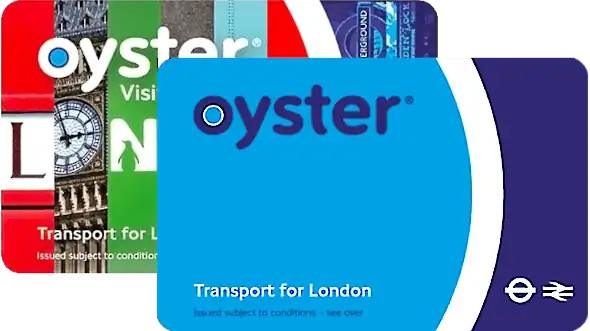
Paying with Oyster
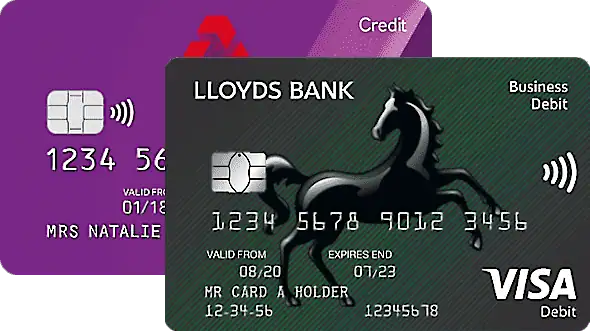
Paying with contactless
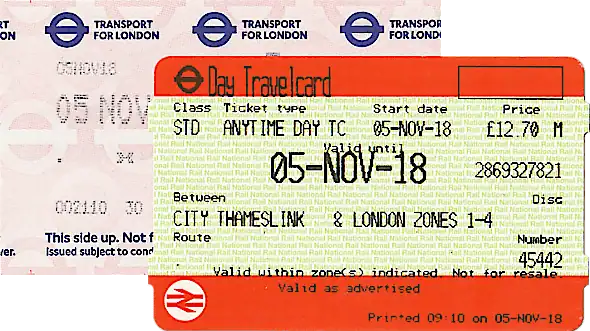
Paying with a travelcard
Can you buy a ticket on the train?
No. You have to buy a paper ticket, travelcard or Oyster card before you board the train. It’s not possible to buy one onboard.
How much is a return fare on the London Underground?
There are no return fares on the London Underground.
It is possible to select a return journey at a self-service ticket machine, but you’ll just be paying the same price as two single journeys and end up receiving two single tickets.
What is the daily and weekly price cap?
Daily price cap – Oyster tube fares and contactless tube fares have a daily price cap . This is the maximum daily charge that will be taken from your card each day – regardless of how many journeys you make. The computer keeps track of all the individual journeys you make throughout the day, totals them up, and as soon as the accumulated amount reaches the daily cap it will stop charging you.
The daily cap is always cheaper than buying a 1-day travelcard .
Note: You must remember to use the same card for every journey, otherwise the computer won’t recognise that they all came from you. Likewise, if you’re using contactless through your mobile phone or watch, then you must use the same device each time.
Weekly price cap – Oyster cards and contactless cards also have a weekly price cap . This works in exactly the same way as the daily cap, but will limit your seven day spend to the same price as a 7 day travelcard .
Important note: the weekly cap only works between Monday and Sunday, so if you’re travelling between any other stretch of seven days (like Friday to Thursday, for example) then the computer will charge you for seven individual days instead.
What time is Peak, Off-Peak and Anytime?
For Oyster and contactless – Oyster fares and contactless fares are described as being Peak and Off-peak .
Peak time is between 6.30-9.30 AM and 4-7 PM (Monday to Friday). Anything else is off-peak , including public holidays. Note: Between the 8th March and 31st May 2024 TFL are running a trial called ‘Off-Peak Friday Fares’, where Fridays will be classed as off-peak all day.
For travelcards – Travelcards are slightly different because they’re described as being Anytime and Off-peak .
Anytime means that you can travel at any time of day, and up to 4.30 AM the following morning. Off-peak is any time after 9.30 AM (Monday to Friday), and up to 4.30 AM the following morning. Weekends and public holidays are always off-peak.
Note: Underground fares are worked out according to what time your journey begins . It doesn’t matter what time your tube journey finishes. So an Oyster journey between 6 AM and 7 AM on a Monday is off-peak . Between 9 AM and 10 AM it’s peak . For a travelcard both journeys are anytime .
What is the cheapest way to travel on the tube?
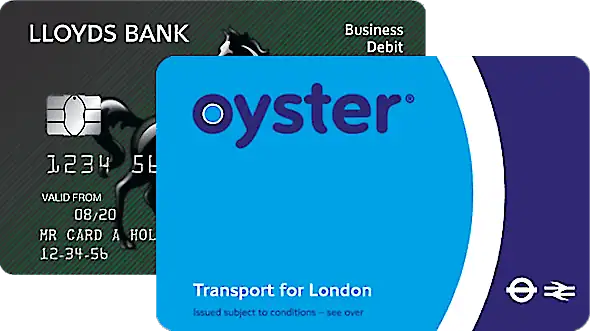
The cheapest way to travel on the tube is with contactless and Oyster – but contactless is usually the better option for UK visitors because you also have to pay a £7 deposit the first time you buy an Oyster card.
We don’t recommend contactless cards for foreign visitors because your bank might add on a transaction fee every time you use it overseas, which will bump up the price of your train ticket.
Try and avoid paying by cash on the London Underground as well, because that always has the highest charges.
Do children get cheap train fares?
Yes. Children under the age of 11 can travel for free on the tube if they’re accompanied by an adult, or they have a 5-10 Zip Oyster photocard. Children aged between 11-17 do have to pay, but they can benefit from cheaper fares if they’re carrying the right photocard, or they have the ‘Young Visitor Discount’ applied to their London Oyster card .
See our child tube fares page for more details.
Do seniors get cheap train fares?
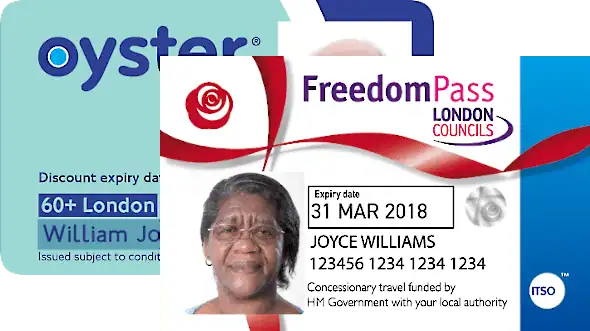
Senior citizens who live in a London borough are eligible for free or discounted travel on the London Underground. (Senior citizens who live outside London can use their OAP pass for free travel on London buses , but not the trains.)
Freedom Pass – If you’re old enough to receive a woman’s state pension (regardless of whether you’re a man or a woman), and your principal home is in London, then you can get hold of a Freedom Pass .
This entitles you to travel for free outside of the morning peak period (4.30 AM to 9 AM, Monday to Friday) on London buses, the London Underground, London Overground, TFL Rail and some National Rail trains within London.
Freedom Passes are supplied by your local council and you can apply online at londoncouncils.gov.uk .
60+ London Oyster photocard – If you’re aged 60 or more and you live in a London borough then you can apply for a 60+ Oyster Card . This allows you to travel for free outside of the morning peak period (4.30 AM to 9 AM, Monday to Friday) on the buses, London Underground, London Overground, TFL Rail and some National Rail services within London.
You can apply for a card online at tfl.gov.uk/fares/free-and-discounted-travel .
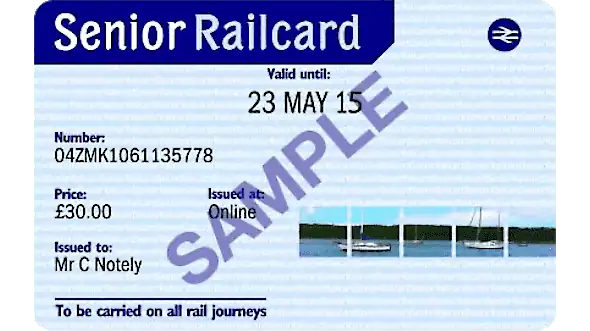
Senior Railcard – If you’re aged 60 or more and you’re travelling on the London Underground and a few National Rail trains then you might benefit from buying a Senior Railcard .
This entitles you to a ⅓-off train fares throughout Britain. You can also have the discount card loaded straight onto your Oyster card and get a ⅓-off pay-as-you-go fares and a ⅓-off the daily price cap (off-peak travel times only).
Make sure you read the terms and conditions carefully though, because it’s usually not valid during peak hours (the peak times will vary depending on which part of the country you’re travelling in) – but given how expensive train tickets are these days it might pay for itself after just three or four journeys.
What is a Two Together Railcard?
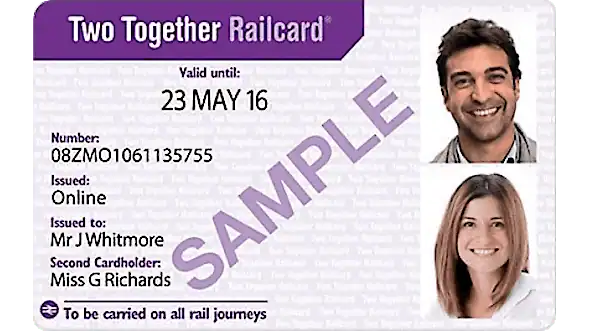
A Two Together Railcard offers discounted train tickets if you’re travelling with your partner to other parts of the UK. But it has to be the same person each time because it will have your names and photos printed on the front (or inside the app, if you’re using contactless). If you want to make a journey on your own during that period then you’ll have to pay normal price.
Another downside when compared to other Railcards is that you can’t use it to get a discount on Oyster pay-as-you-go fares, or Oyster daily caps – but you can use it to get a discount on day travelcards when bought together with a ticket for a National Rail train coming into London.
Check out their website at railcard.co.uk .
What is a Family & Friends Railcard?
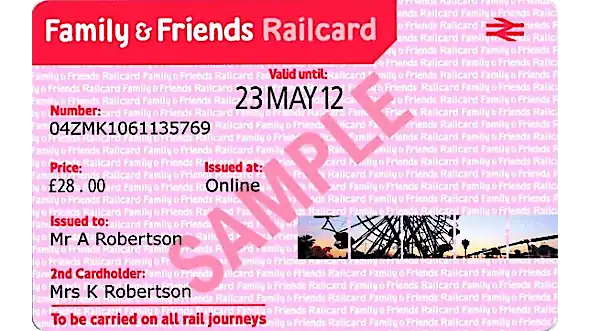
A Family & Friends Railcard offers cheap train tickets if your group size is up to 4 adults and up to 4 kids, but if the majority of your holiday is inside London then beware… because the only useful discount you’ll get is ⅓-off 1 day travelcards when bought together with a National Rail train ticket coming into London (subject to a minimum fare). And it doesn’t apply at peak-time either.
Check out their website at railcard.co.uk if you’re interested.
What is a Disabled Persons Railcard?
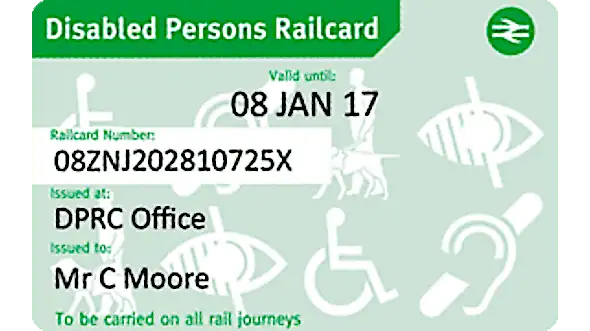
A Disabled Persons Railcard offers cheap train tickets if you have a disability that meets their eligibility criteria .
After you’ve linked the pass to your Oyster card you’ll get a ⅓-off pay-as-you-go fares and daily price caps. You can also get a travelling companion some money off the cost of a day travelcard if it’s bought in conjunction with a National Rail ticket coming into London.
Find out more at railcard.co.uk .
How do you work out a London Underground fare?
In order to work out your London Underground fare you will need to know every fare zone that your journey passes through (not just the ones you start and finish at). You can use our train journey planner to do this.
For example, if you look at the tube ticket prices on our Heathrow to King’s Cross page then you’ll see that the journey passes through zones 1 to 6.
Just to make things a little bit more confusing, some of London’s underground stations are in two different zones at once. Earl’s Court station , for example, is in zones 1 and 2. The charge for these stations is based on your direction of travel. If your journey begins at Earl’s Court and heads towards zone 1 then Earl’s Court will count as zone 1. If you’re heading towards zone 2 then it will count as zone 2. And if your journey finishes at Earl’s Court then it will count as zone 1 if you came from zone 1. And it will count as zone 2 if you came from zone 2.
Do you have to pay twice if you change trains?
If you change trains during your journey then you only have to pay one fare – assuming you don’t exit any of the stations in-between.
For example, if you’re travelling between Waterloo and South Kensington then you’ll have to change trains at Westminster, but you’ll be able to walk between the platforms without passing through any ticket barriers. If you did pass through a barrier then that would be the end of your journey.
How do you use paper tickets on the London Underground?

Using paper tickets on the London Underground is easy. Just insert your single ticket or paper travelcard face-up into the slot at the front of the ticket barrier (underneath that big yellow Oyster reader). The same ticket will then pop out of the slot on the top. The gate won’t open until you remove your ticket from this slot (something that catches a lot of people out).
If your travelcard has been loaded onto a London Oyster card then it’s a little bit easier, because all you have to do is wave it in front of the yellow reader and the gate will open automatically.
How do you use Oyster and contactless cards on the tube?
Using contactless cards and Oyster cards on the London Underground is easy. All you have to do is wave them in front of the big yellow reader by the gate. If the machine registers it correctly then the ticket barrier will open automatically for you to walk through.
If it doesn’t work then try taking your card out of your purse or wallet and touching it flush against the reader. If it still doesn’t work then look at the little LCD screen by the reader to see what it says (you’re probably out of credit).
If you’re travelling from a suburban station outside central London then you might find that it doesn’t have any gates, and the readers will either be at the foot of the platform stairs or on the platform itself.
When you leave the train at the end of your journey you will need to tap your card down again, so the computer can work out which fare zones you travelled through. You need to do this even if there’s no barrier, or when the barrier has been deliberately left open by the TFL staff (which they sometimes do to speed the flow of passengers during rush hour). If you forget to touch your card down then the system will whack you for a maximum fare (ouch!).
Which is best: cash, contactless, Oyster card or travelcard?
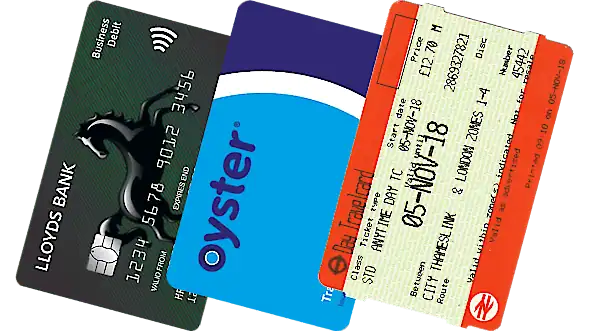
Cash fares on the London Underground are considerably more expensive so they should be avoided unless it’s just a one-off journey.
Day travelcards are surprisingly expensive when compared to the contactless and Oyster daily cap , but lots of tourists like the simplicity of being able to buy a travelcard straight from a self-service machine. (You also have to pay a £7 deposit the first time you buy an Oyster card, which will wipe out any savings you make if you’re only staying in the city for one day.)
Contactless and Oyster have the joint cheapest fares on the tube, but contactless is more convenient for UK visitors because of that £7 deposit. We don’t recommend contactless for foreign visitors because your bank might add on a transaction fee every time you buy a train ticket overseas.
Note: If you’re staying in London for a week and you’re planning on making three or more tube journeys on six days, or two or more on seven days, then a weekly travelcard might work out cheaper – but only if you’re not staying from Monday to Sunday. (That’s because the weekly cap on Oyster and contactless only applies from Monday to Sunday, whereas a travelcard can start on any day you like.)
The verdict: Contactless is always the best option for UK visitors. A 1-day travelcard is the best option for foreign tourists staying for just one day. Oyster is the best option for foreign tourists staying for more than one day, and a weekly travelcard might be the cheapest option if you’re staying for 6-7 days, depending on how many journeys you make.
Your comments and questions
Daniel Hi everyone. I'm going to spend the whole of January in London for a course. I'll stay in West Hampstead and the course is in the Swiss Cottage area (walking distance). Since my course will be less than 3 hours daily from Monday to Friday, I'll have a lot of free time to visit the city. I'm planning on getting a one-month Oyster card, but I'm in doubt as to which zones should I get covered for tourism purposes. What do you suggest? Is coverage for zones 1 and 2 enough? Thanks! Daniel
Staff It will probably be enough, but of course it depends where you want to go. Most people do spend their entire holiday inside zones 1-2. You might be better off just using your contactless bank card because then you can go wherever you like and you won't be restricted to zones. But depending on how many trips you actually make a monthly travelcard might work out a bit cheaper - unfortunately the only way of knowing for sure is to total up all the journeys you'll be making
JPH Hi everyone, I have a question for you. I take the tube from the station Blackhorse (zone 3) and I change at Highbury&Islington (zone 2). From there I take the train to Whitechapel (zone2). My question is: why I have to pay for a ticket 2.40? When I have a one week travelcard zone 2&3 I still pay? Why? Can anyone tell me?
Staff Even though none of those stations are in zone 1, if you look at a tube map you'll see that the journey does actually pass through zone 1. Your travelcard already covers zones 2&3, so the computer just charges you the extra bit for zone 1 (I'm assuming that you've got your travelcard loaded on to an Oyster card)
JPH Thank you for your explanation.
Wendy Hi. I have a bus pass on my Oyster - can I use this on the tube? Thanks Wendy
Staff Hi. It depends what you've bought. It is possible to buy travelcards that only cover the bus (and tram). If you've got one of those then you won't be able to use that on the tube. But you can also buy ones that cover the buses, tubes and trams together. So that would be okay.
Drew If I get on the train before peak time [4pm] but off the train in peak time, how will I be charged?
Staff Hi Drew, it goes by what time your journey starts. So if you board the train in off-peak, you will be charged off-peak. It doesn't matter what time your journey finishes.
Nads Can I buy the ticket for zone 1-2 in advance, online?
Staff Hi Nads. Not a single ticket, no. You can only buy those at the station on the day. You can buy a zone 1-2 travelcard online in advance, and have them post it to you, but they don't do 1-day travelcards for those zones, only weekly, monthly or annual ones.
MRyan Just a word of caution for everyone using Oyster/contactless payment cards. Make sure your Oyster card and contactless card are not in the same pouch or wallet when you tap in or out. You may find (as I did to my cost) that you are tapped in on one card and tapped in again on the other rather than tapped out on the original one. You will then be charged twice rather than just the fare for the journey you made. The good news is that can get a refund by e-mailling TFL with times and dates of the journeys made. I only realised when I got my bank statement that I had slipped up repeatedly during the previous month. Now the cards are kept completely separate!
Judy 2 seniors visiting London and staying in Chelsea. Family is also visiting London and lodging near the British Museum. I think I understand the Oyster card may be our most economical way of traveling around the city. I am assuming that we can access both tube and bus using the cards? Haven't figured out the zones, yet, but City center and Kensington Gardens are both on our list of places we will be going to. Any suggestions?
Staff Hi Judy. You can use an Oyster card on both the bus and tube... or you can just pay with your contactless card instead (your bank card), which is a bit easier. They have exactly the same fares as Oyster, and you don't have to pay the £7 deposit to set it up. Some people don't like the idea of using their bank card though (like me), so maybe you'll prefer paying with Oyster. All of the places you've mentioned are inside zone 1.
S MacDonald What discounts applied if you are over sixty?
Staff Hi. If you're a tourist from abroad then there aren't any. If you live in a London borough then you can travel for free on the trains if you get hold of a 60+ Oyster card. But they only work until you're old enough to apply for a Freedom Pass. More details here: londondrum.com/transport/senior-train-fares.php
Gudjonsson If I hold my wallet to the card reader intending to pay with my Oyster card, could the computer debit my bank account for a contactless payment, if my debit card happened to be in the same wallet? In other words: do you need to be careful not to inadvertently present two or more cards to the reader at the same time?
Staff Hi Gudjonsson. It could do, yes. If it detects two cards then it will probably reject both cards and not let you through until you separate them, but it could register one card. If you then turn your wallet up the other way when leaving the train it might register the other, which will mess up the fare and daily cap. So it's best to keep them separate.
Jane Are the prices quoted single or return fares?
Staff Hi Jane. There's no such thing as return fares on the underground. You can buy return tickets at the machine, but you'll just be paying the same as two singles
Baxter Why is paying by cash more expensive than using a contactless card, it's double the price!
Staff Hi Baxter. Good question. I suppose they're trying to encourage people to use them, because then they won't need so many ticket windows and ticket machines - keeps their costs down
Russell If you get on a train at 15.55 off-peak and change trains and get off your destination an hour later at 16.55 is it still classed as off-peak? With an Oyster card. Regards.
Staff Hi Russell. That's right, yes. The only time that matters is when you board the train. If you board the train during off-peak hours then it will be charged as off-peak, even if you get off again during peak hours
Caroline Wah How much money should I top up on my Oyster card?
Staff Hi Caroline. It depends how many days you're staying, and where you want to travel to. The maximum amount you'll spend each day is the 'daily cap' for the zones you travel through (shown in the table above). Most tourists tend to spend their entire holiday inside zones 1 and 2. So just add enough to cover the daily cap each day
Rahmah Hi, we are Malaysians (3 paxs). Can we buy weekly ticket on senior citizen fares. We will be visiting London for 10 days. Thank you
Staff Hi Rahmah. Unfortunately not, no. Cheap fares for senior citizens are only available for UK citizens or people who actually live in London. An Oyster card will probably work out cheaper for you, rather than a weekly travelcard, but it all depends on how many journeys you're making in total. Bear in mind that a weekly travelcard has to be used over seven consecutive days. you can't spread the seven days over a stay of ten
Robin Is there a disabled price for zone 1 travel?
Staff Hi Robin, not if you just turn up on the day, but you can get discounted travel if you apply for a disabled persons railcard or freedom pass before you travel - londoncouncils.gov.uk/services/freedom-pass/disabled-persons-freedom-pass . It's different on the buses because people in wheelchairs can travel for free without needing any kind of pass
Tony Hi. Are the contactless prices including the return journey so there and back? Or just one way?
Staff Hi Tony. It's just one way. There are no return prices on the underground - you just pay the same as two singles
Shanzey We are British citizen. Want to travel to london from 10th to 17th of August (Thursday to Wednesday). We want to go to see lonfin Eye, green street, South Hall, Emirates cable cars ,museum, famous parks etc. Two of my kids are 15 and 13th of age. We are traveling by train from oxford to southwoodford area. I am not sure which option would be cheapest for us. I have rail card as well. Many thanks
Staff Hi Shanzey. Your 13 year old should get an Oyster card with the 'Young Visitor Discount' applied to it - as explained here londondrum.com/transport/child-train-fares.php . The others might be better off with a travelcard, which can work out cheaper if you make at least 2 journeys on each of the seven days, but maybe it will be simpler just to get Oyster cards for everyone. Not sure what you mean by Green Street and South Hall, but zones 1-2 will cover the other places
Terri What is the cost from bow church dlr to Lewisham dlr
Staff Hi Terri. It depends on how you're paying. All the prices are here - londondrum.com/transport/train-journey.php?from=bow-church&to=lewisham
Michael Living in Mile End and will be travelling from Mile end underground to Farringdon 5x a week there. And will be getting a bus from Holborn circus to regents canal 5x a week back. This will be weekly for next 2 years. I am eligible for 16-25 railcard and would like to know whether it will be cheaper to do contactless or oyster, Thanks
Staff Hi Michael. Oyster and contactess are exactly the same price (apart from the £7 deposit you have to pay the first time you buy the oyster card). It's not possible to load the railcard onto a contactless card, though. So you should probably get an oyster card. But check the railcard rules apply to your train times - 16-25railcard.co.uk/help/faqs/
Will Bolt Hi, why was I charged £6.40 for travel in zone 1 when it should have been £2.70. I touched in at Waterloo and out at Liverpool Street
Staff Hi Will. TFL don't charge you straight away for each individual journey. Their system usually totals up all the journeys you've made during the day and then charges you in one lump sum at the end. Our guess would be that £6.40 is for a couple of different journeys. If its a contactless card you can get a 7-day journey history, even if you havent registered, and see whats going on - contactless.tfl.gov.uk/
Colin Do service veterans get discount prices when attending the Cenotaph Remembrance Parade
Staff Hi Colin. You might be able to apply for a Veterans Oyster card for free or discounted travel on the buses, London underground and some National Rail trains. More info here -- tfl.gov.uk/fares/free-and-discounted-travel/veterans-oyster-photocard
Syl What's the difference between a UK visitor and a foreign visitor when you say you do not recommend contactless for foreign visitors. I am a senior from New Zealand and have a Wise multi currency card. I will be traveling by train to Scotland and plan to stay in London for 6-7 days.What is the best card to get and can I get it from New Zealand before I start mu travel.
Staff Hi Syl. The reason we say that, is because if you have a bank card issued overseas then your bank might add on a transaction fee every time you buy a bus or train ticket, because it's in a different currency. And that will make them a lot more expensive compared with using an Oyster card, for example. So you might want to check with your bank first. Otherwise we would suggest getting a Visitor Oyster card, which can be posted overseas before you go - londondrum.com/transport/visitor-oyster-cards.php
Ann Hi If i get a senior rail card for two together will I only be charged one £30, & can either persona use it if travelling alone.
Staff Hi Ann. If you both want a senior rail card then you'll have to buy one each, and they're tied with your name, so you wouldn't be able to share one senior rail card between two
You must enable javascript to leave a comment
2018 Primetime Emmy & James Beard Award Winner
In Transit: Notes from the Underground
Jun 06 2018.
Spend some time in one of Moscow’s finest museums.
Subterranean commuting might not be anyone’s idea of a good time, but even in a city packing the war-games treasures and priceless bejeweled eggs of the Kremlin Armoury and the colossal Soviet pavilions of the VDNKh , the Metro holds up as one of Moscow’s finest museums. Just avoid rush hour.
The Metro is stunning and provides an unrivaled insight into the city’s psyche, past and present, but it also happens to be the best way to get around. Moscow has Uber, and the Russian version called Yandex Taxi , but also some nasty traffic. Metro trains come around every 90 seconds or so, at a more than 99 percent on-time rate. It’s also reasonably priced, with a single ride at 55 cents (and cheaper in bulk). From history to tickets to rules — official and not — here’s what you need to know to get started.
A Brief Introduction Buying Tickets Know Before You Go (Down) Rules An Easy Tour
A Brief Introduction
Moscow’s Metro was a long time coming. Plans for rapid transit to relieve the city’s beleaguered tram system date back to the Imperial era, but a couple of wars and a revolution held up its development. Stalin revived it as part of his grand plan to modernize the Soviet Union in the 1920s and 30s. The first lines and tunnels were constructed with help from engineers from the London Underground, although Stalin’s secret police decided that they had learned too much about Moscow’s layout and had them arrested on espionage charges and deported.
The beauty of its stations (if not its trains) is well-documented, and certainly no accident. In its illustrious first phases and particularly after the Second World War, the greatest architects of Soviet era were recruited to create gleaming temples celebrating the Revolution, the USSR, and the war triumph. No two stations are exactly alike, and each of the classic showpieces has a theme. There are world-famous shrines to Futurist architecture, a celebration of electricity, tributes to individuals and regions of the former Soviet Union. Each marble slab, mosaic tile, or light fixture was placed with intent, all in service to a station’s aesthetic; each element, f rom the smallest brass ear of corn to a large blood-spattered sword on a World War II mural, is an essential part of the whole.

The Metro is a monument to the Soviet propaganda project it was intended to be when it opened in 1935 with the slogan “Building a Palace for the People”. It brought the grand interiors of Imperial Russia to ordinary Muscovites, celebrated the Soviet Union’s past achievements while promising its citizens a bright Soviet future, and of course, it was a show-piece for the world to witness the might and sophistication of life in the Soviet Union.
It may be a museum, but it’s no relic. U p to nine million people use it daily, more than the London Underground and New York Subway combined. (Along with, at one time, about 20 stray dogs that learned to commute on the Metro.)
In its 80+ year history, the Metro has expanded in phases and fits and starts, in step with the fortunes of Moscow and Russia. Now, partly in preparation for the World Cup 2018, it’s also modernizing. New trains allow passengers to walk the entire length of the train without having to change carriages. The system is becoming more visitor-friendly. (There are helpful stickers on the floor marking out the best selfie spots .) But there’s a price to modernity: it’s phasing out one of its beloved institutions, the escalator attendants. Often they are middle-aged or elderly women—“ escalator grandmas ” in news accounts—who have held the post for decades, sitting in their tiny kiosks, scolding commuters for bad escalator etiquette or even bad posture, or telling jokes . They are slated to be replaced, when at all, by members of the escalator maintenance staff.
For all its achievements, the Metro lags behind Moscow’s above-ground growth, as Russia’s capital sprawls ever outwards, generating some of the world’s worst traffic jams . But since 2011, the Metro has been in the middle of an ambitious and long-overdue enlargement; 60 new stations are opening by 2020. If all goes to plan, the 2011-2020 period will have brought 125 miles of new tracks and over 100 new stations — a 40 percent increase — the fastest and largest expansion phase in any period in the Metro’s history.
Facts: 14 lines Opening hours: 5 a.m-1 a.m. Rush hour(s): 8-10 a.m, 4-8 p.m. Single ride: 55₽ (about 85 cents) Wi-Fi network-wide

Buying Tickets
- Ticket machines have a button to switch to English.
- You can buy specific numbers of rides: 1, 2, 5, 11, 20, or 60. Hold up fingers to show how many rides you want to buy.
- There is also a 90-minute ticket , which gets you 1 trip on the metro plus an unlimited number of transfers on other transport (bus, tram, etc) within 90 minutes.
- Or, you can buy day tickets with unlimited rides: one day (218₽/ US$4), three days (415₽/US$7) or seven days (830₽/US$15). Check the rates here to stay up-to-date.
- If you’re going to be using the Metro regularly over a few days, it’s worth getting a Troika card , a contactless, refillable card you can use on all public transport. Using the Metro is cheaper with one of these: a single ride is 36₽, not 55₽. Buy them and refill them in the Metro stations, and they’re valid for 5 years, so you can keep it for next time. Or, if you have a lot of cash left on it when you leave, you can get it refunded at the Metro Service Centers at Ulitsa 1905 Goda, 25 or at Staraya Basmannaya 20, Building 1.
- You can also buy silicone bracelets and keychains with built-in transport chips that you can use as a Troika card. (A Moscow Metro Fitbit!) So far, you can only get these at the Pushkinskaya metro station Live Helpdesk and souvenir shops in the Mayakovskaya and Trubnaya metro stations. The fare is the same as for the Troika card.
- You can also use Apple Pay and Samsung Pay.
Rules, spoken and unspoken
No smoking, no drinking, no filming, no littering. Photography is allowed, although it used to be banned.
Stand to the right on the escalator. Break this rule and you risk the wrath of the legendary escalator attendants. (No shenanigans on the escalators in general.)
Get out of the way. Find an empty corner to hide in when you get off a train and need to stare at your phone. Watch out getting out of the train in general; when your train doors open, people tend to appear from nowhere or from behind ornate marble columns, walking full-speed.
Always offer your seat to elderly ladies (what are you, a monster?).
An Easy Tour
This is no Metro Marathon ( 199 stations in 20 hours ). It’s an easy tour, taking in most—though not all—of the notable stations, the bulk of it going clockwise along the Circle line, with a couple of short detours. These stations are within minutes of one another, and the whole tour should take about 1-2 hours.
Start at Mayakovskaya Metro station , at the corner of Tverskaya and Garden Ring, Triumfalnaya Square, Moskva, Russia, 125047.
1. Mayakovskaya. Named for Russian Futurist Movement poet Vladimir Mayakovsky and an attempt to bring to life the future he imagined in his poems. (The Futurist Movement, natch, was all about a rejecting the past and celebrating all things speed, industry, modern machines, youth, modernity.) The result: an Art Deco masterpiece that won the National Grand Prix for architecture at the New York World’s Fair in 1939. It’s all smooth, rounded shine and light, and gentle arches supported by columns of dark pink marble and stainless aircraft steel. Each of its 34 ceiling niches has a mosaic. During World War II, the station was used as an air-raid shelter and, at one point, a bunker for Stalin. He gave a subdued but rousing speech here in Nov. 6, 1941 as the Nazis bombed the city above.

Take the 3/Green line one station to:
2. Belorusskaya. Opened in 1952, named after the connected Belarussky Rail Terminal, which runs trains between Moscow and Belarus. This is a light marble affair with a white, cake-like ceiling, lined with Belorussian patterns and 12 Florentine ceiling mosaics depicting life in Belarussia when it was built.

Transfer onto the 1/Brown line. Then, one stop (clockwise) t o:
3. Novoslobodskaya. This station was designed around the stained-glass panels, which were made in Latvia, because Alexey Dushkin, the Soviet starchitect who dreamed it up (and also designed Mayakovskaya station) couldn’t find the glass and craft locally. The stained glass is the same used for Riga’s Cathedral, and the panels feature plants, flowers, members of the Soviet intelligentsia (musician, artist, architect) and geometric shapes.

Go two stops east on the 1/Circle line to:
4. Komsomolskaya. Named after the Komsomol, or the Young Communist League, this might just be peak Stalin Metro style. Underneath the hub for three regional railways, it was intended to be a grand gateway to Moscow and is today its busiest station. It has chandeliers; a yellow ceiling with Baroque embellishments; and in the main hall, a colossal red star overlaid on golden, shimmering tiles. Designer Alexey Shchusev designed it as an homage to the speech Stalin gave at Red Square on Nov. 7, 1941, in which he invoked Russia’s illustrious military leaders as a pep talk to Soviet soldiers through the first catastrophic year of the war. The station’s eight large mosaics are of the leaders referenced in the speech, such as Alexander Nevsky, a 13th-century prince and military commander who bested German and Swedish invading armies.

One more stop clockwise to Kurskaya station, and change onto the 3/Blue line, and go one stop to:
5. Baumanskaya. Opened in 1944. Named for the Bolshevik Revolutionary Nikolai Bauman , whose monument and namesake district are aboveground here. Though he seemed like a nasty piece of work (he apparently once publicly mocked a woman he had impregnated, who later hung herself), he became a Revolutionary martyr when he was killed in 1905 in a skirmish with a monarchist, who hit him on the head with part of a steel pipe. The station is in Art Deco style with atmospherically dim lighting, and a series of bronze sculptures of soldiers and homefront heroes during the War. At one end, there is a large mosaic portrait of Lenin.

Stay on that train direction one more east to:
6. Elektrozavodskaya. As you may have guessed from the name, this station is the Metro’s tribute to all thing electrical, built in 1944 and named after a nearby lightbulb factory. It has marble bas-relief sculptures of important figures in electrical engineering, and others illustrating the Soviet Union’s war-time struggles at home. The ceiling’s recurring rows of circular lamps give the station’s main tunnel a comforting glow, and a pleasing visual effect.

Double back two stops to Kurskaya station , and change back to the 1/Circle line. Sit tight for six stations to:
7. Kiyevskaya. This was the last station on the Circle line to be built, in 1954, completed under Nikita Khrushchev’ s guidance, as a tribute to his homeland, Ukraine. Its three large station halls feature images celebrating Ukraine’s contributions to the Soviet Union and Russo-Ukrainian unity, depicting musicians, textile-working, soldiers, farmers. (One hall has frescoes, one mosaics, and the third murals.) Shortly after it was completed, Khrushchev condemned the architectural excesses and unnecessary luxury of the Stalin era, which ushered in an epoch of more austere Metro stations. According to the legend at least, he timed the policy in part to ensure no Metro station built after could outshine Kiyevskaya.

Change to the 3/Blue line and go one stop west.
8. Park Pobedy. This is the deepest station on the Metro, with one of the world’s longest escalators, at 413 feet. If you stand still, the escalator ride to the surface takes about three minutes .) Opened in 2003 at Victory Park, the station celebrates two of Russia’s great military victories. Each end has a mural by Georgian artist Zurab Tsereteli, who also designed the “ Good Defeats Evil ” statue at the UN headquarters in New York. One mural depicts the Russian generals’ victory over the French in 1812 and the other, the German surrender of 1945. The latter is particularly striking; equal parts dramatic, triumphant, and gruesome. To the side, Red Army soldiers trample Nazi flags, and if you look closely there’s some blood spatter among the detail. Still, the biggest impressions here are the marble shine of the chessboard floor pattern and the pleasingly geometric effect if you view from one end to the other.

Keep going one more stop west to:
9. Slavyansky Bulvar. One of the Metro’s youngest stations, it opened in 2008. With far higher ceilings than many other stations—which tend to have covered central tunnels on the platforms—it has an “open-air” feel (or as close to it as you can get, one hundred feet under). It’s an homage to French architect Hector Guimard, he of the Art Nouveau entrances for the Paris M é tro, and that’s precisely what this looks like: A Moscow homage to the Paris M é tro, with an additional forest theme. A Cyrillic twist on Guimard’s Metro-style lettering over the benches, furnished with t rees and branch motifs, including creeping vines as towering lamp-posts.

Stay on the 3/Blue line and double back four stations to:
10. Arbatskaya. Its first iteration, Arbatskaya-Smolenskaya station, was damaged by German bombs in 1941. It was rebuilt in 1953, and designed to double as a bomb shelter in the event of nuclear war, although unusually for stations built in the post-war phase, this one doesn’t have a war theme. It may also be one of the system’s most elegant: Baroque, but toned down a little, with red marble floors and white ceilings with gilded bronze c handeliers.

Jump back on the 3/Blue line in the same direction and take it one more stop:
11. Ploshchad Revolyutsii (Revolution Square). Opened in 1938, and serving Red Square and the Kremlin . Its renowned central hall has marble columns flanked by 76 bronze statues of Soviet heroes: soldiers, students, farmers, athletes, writers, parents. Some of these statues’ appendages have a yellow sheen from decades of Moscow’s commuters rubbing them for good luck. Among the most popular for a superstitious walk-by rub: the snout of a frontier guard’s dog, a soldier’s gun (where the touch of millions of human hands have tapered the gun barrel into a fine, pointy blade), a baby’s foot, and a woman’s knee. (A brass rooster also sports the telltale gold sheen, though I am told that rubbing the rooster is thought to bring bad luck. )
Now take the escalator up, and get some fresh air.

R&K Insider
Join our newsletter to get exclusives on where our correspondents travel, what they eat, where they stay. Free to sign up.
21 Things to Know Before You Go to Moscow
Featured city guides.
New York transit agency votes to indefinitely halt Manhattan congestion pricing
- Medium Text
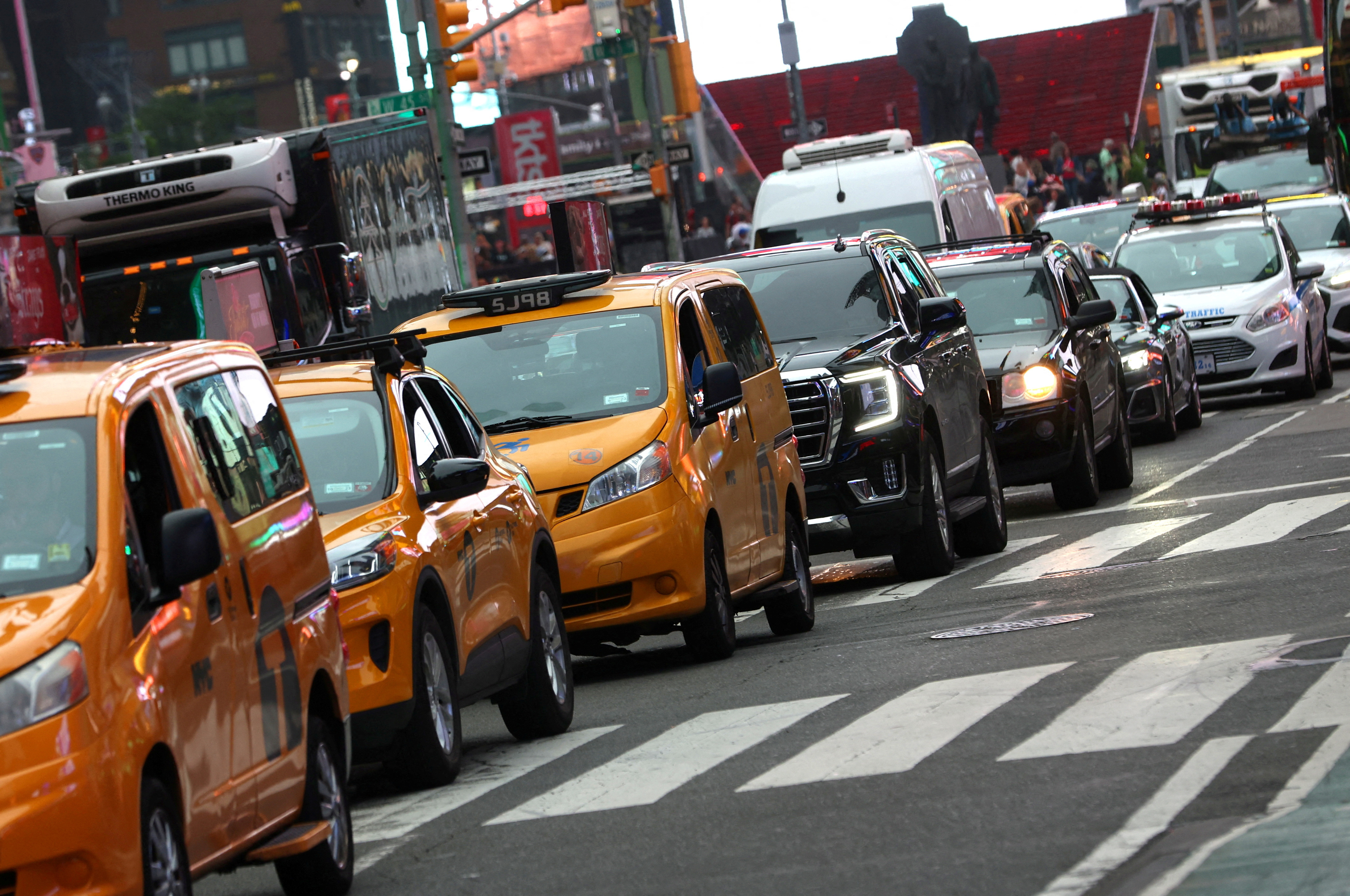
Sign up here.
Reporting by David Shepardson in Washington and Jonathan Allen in New York; Editing by Bill Berkrot and Diane Craft
Our Standards: The Thomson Reuters Trust Principles. New Tab , opens new tab

World Chevron
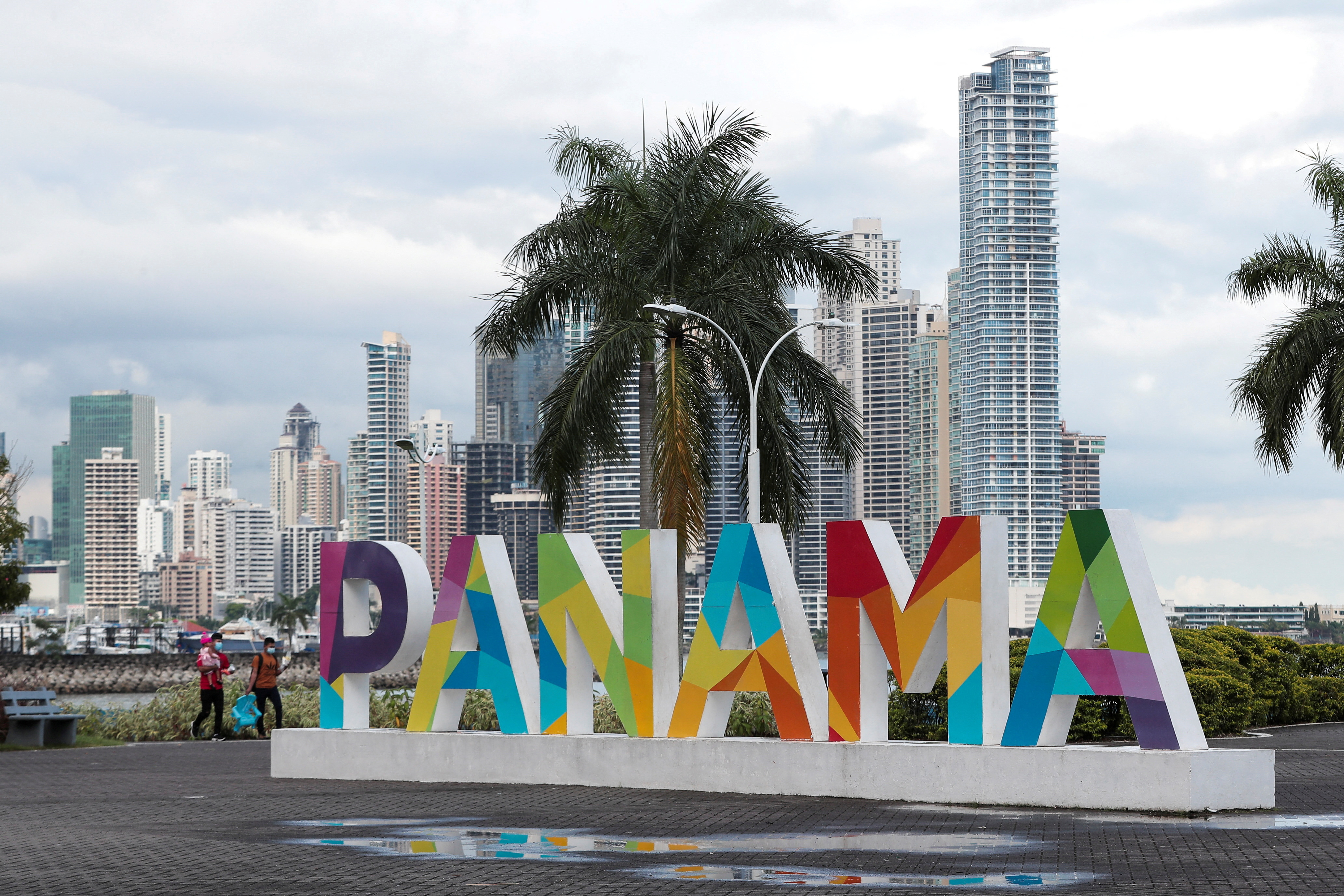
Panama court acquits 28 people tied to Panama Papers, Operation Car Wash
A Panamanian court has acquitted 28 people charged with money-laundering under cases linked to the Panama Papers and "Operation Car Wash" scandals, the country's judicial branch said in a statement on Friday.

- Bahasa Indonesia
- Slovenščina
- Science & Tech
- Russian Kitchen
The city beneath the city: Moscow’s underground world
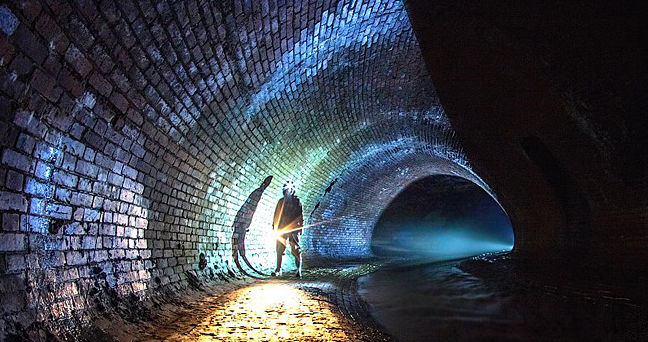
Tunnels, bunkers and underground rivers: discover Moscow's subterranean city. Source: Mosextreme.ru
Bunker No. 42
This underground bunker next to Taganskaya metro station was built in the 1950s at the height of the Cold War. Its entrance is camouflaged by an ordinary 19th-century house with its walls hiding a six-meter thick cement cap. The bunker itself is located at a depth of 65 meters (or the equivalent of 17 floors below ground) at the same level as the circle metro line.
This underground complex occupies more than 7,000 square meters and is divided into four blocks of tunnels. The reserve headquarters of the General Staff of the Air Force were located here, so that work could go on even if Moscow was under nuclear attack. The temperature inside the bunker is 16° Celsius.

Source: Bunker No.42 press photo
In 2006 the Museum of the Cold War opened in the bunker. It is an interactive museum: visitors can try on Soviet-era military uniforms, handle the weapons, explore formerly secret tunnels wearing helmets and protection suits, try out the responsibilities of a radiotelegraphist and even “launch” nuclear warheads by pressing the infamous red button.
http://www.bunker42.com/
Stalin’s Bunker
Stalin’s Bunker is located near the Izmailovskaya metro station. Its construction dates back to the 1930s and was planned as the reserve headquarters of the Supreme Commander of the Soviet Union. It was connected to the Kremlin by a 17-kilometer underground tunnel.

Source: elpida.ru
Stalin worked here in late November and early December 1941 at the beginning of World War II. It was in this bunker that the decision was made not to abandon Moscow and to defend it at all costs.
In 1996 the bunker was turned into a museum and opened to visitors. The bunker itself is relatively small with only the most essential spaces: a conference room, an office, a room for rest, the generals’ office, supply rooms and a refectory.
http://www.elpida.ru/stalin
The underground river
.jpg)
Source: mosextreme.ru
The Neglinnaya River is a left tributary of the Moscow River that proceeds for 7.5 kilometers. It is as ancient as the capital itself with the first references to this river in old chronicles coinciding with the first mentions of Moscow.
The river’s origin is in the area near Marina Roshcha. From there it passes under the city center and Aleksandrovsky Garden before flowing into the Moscow River through a big stone opening in the embankment that can be seen from the Bolshoy Kamenny Bridge. The Neglinnaya River flows through a pipe for most of its length. A private company organizes an excursion along one part of the stone tunnel. However, even a planned excursion can be abruptly cancelled because of rain as the water in the river frequently floods.
The Neglinnaya River is considered one of the most mystical places in Moscow: frequent visitors often see ghosts in the tunnel. To enter the stone tunnel you have to go through a sewer located in the area of the Stretensky Boulevard metro station. http://mosextreme.ru/dungeon
Syani stone mines

Source: mosextreme.ru
These stone mines provided the limestone needed to build the fortresses and churches of the white-stone buildings of Moscow. They began to be exploited in the 17 th century. During the Soviet period stone was excavated here to reinforce airplane runways and during World War II a military hospital and later on a seismic station were located here.
In 1974 the entrance to the Syani mines was filled in. By that time its system of underground tunnels exceeded 90 kilometers. On June 3, 1988 underground enthusiasts unsealed one of the entrances and in 2007 it was substantially restored by local inhabitants and regular visitors to the mines.
Regular visitors call themselves “sistemshchiki,” which is slang related to the Soviet hippie movement. A particular subculture has developed around these caves with its traditions, rules, myths and rituals.
The height of the tunnels of the Syani mines network ranges between 0.4 and 3.5 meters and their depth reaches up to 30 meters. The temperature inside the caves is usually in the range of 7-10 °Celsius. To reach the entrance to the caves, take bus number 439 from Domodedovskaya metro station and get off at the stop “Pochta.” The journey takes about 35 minutes.
http://mosextreme.ru/dungeon
All rights reserved by Rossiyskaya Gazeta.
to our newsletter!
Get the week's best stories straight to your inbox
This website uses cookies. Click here to find out more.

The Essex underground station that's probably got the prettiest platforms on the London Underground network
G ants Hill station, a Central Line tube stop in East London, could easily be one of the prettiest on the network. Often mistaken for a station in Moscow, the exterior of the station, located just north of Valentines Park in Redbridge, is rather unassuming.
You might even walk past it if you weren't looking out for the iconic London Underground signs. Access to the station is via stairs leading into subways from the Gants Hill roundabout.
Unlike other distinctive London Underground stations such as the red-tiled Caledonian Road and Russell Square on the Piccadilly Line, Gants Hill doesn't have a striking street-level entrance. However, once you reach platform level, it's a different story.
READ MORE: The Essex pub with stunning views of historic Victorian railway bridge from the garden
READ MORE: The hidden paradise Essex lagoon so pretty you don’t even need to go abroad for a holiday
The impressive open-plan platform boasts a large arched ceiling, grand tiled pillars, and elegant benches positioned in each direction from the centre.
Interestingly, those who have travelled on the Moscow Metro might notice the similarities between Gants Hill station and many of the stations in the Russian capital. In fact, they are so alike that the concourse of the Central line station is often referred to as the 'Moscow Hall', reports MyLondon .
The quirky design elements at the Gants Hill station might just transport you to Moscow, and that's no accident. The particular marvel in architectural design, so distinctly reminiscent of the Moscow Metro, is a brainchild of its designer, Charles Holden.
The London Transport Museum's website boasts: "The arched ceiling and detailed symmetry create an elongated effect that this photograph captures perfectly. Inspired by Holden's visit to the Moscow Metro, this happens to be one of Holden's last commissions for London Transport in 1947."
Taking inspiration from Holden's trip to the Moscow Metro, the design turned out to be one of his final works for London Transport, completed in 1947.
Construction of Gants Hill station originally commenced in the 1930s but was interrupted by World War II, during which time the incomplete station served as an air raid shelter and its tunnels were transformed into a factory for Plessey electronics.
It wasn't until December 14, 1947, that Gants Hill station finally opened its doors to the public, becoming the furthest east underground station on the London Underground network.
Get more news from EssexLive straight to your inbox for FREE

Election latest: Farage urged to 'get a grip' of Reform UK amid racism row
John Healey, the shadow defence secretary, has urged Nigel Farage to "get a grip" of Reform UK after a racism row involving the prime minister. It comes as a Reform UK canvasser who used a racial slur against Rishi Sunak called himself a "total fool" and said he has learned his lesson.
Saturday 29 June 2024 12:30, UK
- General Election 2024
Please use Chrome browser for a more accessible video player
- Farage urged to 'get a grip' of Reform UK
- Reform canvasser in PM racism row says he was 'a total fool'
- Faultlines: Eight-hour school runs and kids too hungry to sleep - the families caught up in housing 'social cleansing'
- Politics at Jack and Sam's : The last weekend
- Live reporting by Faith Ridler
Election essentials
- Manifesto pledges: Conservatives | Greens | Labour | Lib Dems | Plaid | Reform | SNP
- Trackers: Who's leading polls? | Is PM keeping promises?
- Campaign Heritage: Memorable moments from elections gone by
- Follow Sky's politics podcasts: Electoral Dysfunction | Politics At Jack And Sam's
- Read more: Who is standing down? | Key seats to watch | What counts as voter ID? | Check if your constituency is changing | Guide to election lingo
- How to watch election on Sky News
Today is the final Saturday of the general election campaign, with people across the UK preparing to cast their vote on 4 July.
There's still plenty that could happen between now and Thursday - so now isn't the time to turn away.
It's 12.30pm - here's everything you need to know so far:
- Party leaders are on the election campaign trail on Armed Forces Day;
- Rishi Sunak will later hail the "duty, dedication and selfless personal sacrifice" of servicemen and women and claim his is the only party to meet the Help for Heroes Veterans' Pledge;
- Meanwhile, Labour leader Sir Keir Starmer has pledged to introduce a new armed forces commissioner and lead a "government of service" if Labour is elected;
- However, there is another story holding attention today - a racism row involving a Reform UK canvasser and Rishi Sunak;
- Footage from an undercover Channel 4 reporter showed Reform campaigner Andrew Parker using a discriminatory term about the prime minister, as well as saying the army should "just shoot" migrants crossing the Channel;
- The canvasser has called himself a "total fool" and said he has learned his lesson;
- But John Healey, the shadow defence secretary, has urged Nigel Farage to "get a grip" of Reform UK after a racism row involving the prime minister.
- Sir Keir Starmer has also commented today, urging Mr Farage to "set the tone" in his party;
- And Tom Tugendhat , the security minister, has criticised those "in Nigel Farage's company" who have "rather extraordinary and unpleasant views".
Stick with us through the afternoon for the latest news and analysis from the campaign trail.
Our live poll tracker collates the results of opinion surveys carried out by all the main polling organisations - and allows you to see how the political parties are performing in the run-up to the general election.
With under a week to go, the Tories and Labour have taken a drop, while support for Reform UK and the Liberal Democrats is on the rise.
Read more about the tracker here .
Sir Keir Starmer today refused to say whether David Lammy would be his foreign secretary under a Labour government.
Speaking to reporters, the Labour leader said he will "work hard until 10 o'clock on Thursday" to get votes, adding: "I'm not going to announce anybody who may be in a cabinet after Thursday if we win."
Asked if he was concerned about the prospect of a super-majority, Sir Keir said that "the numbers are really tight, it'll go down to a few hundred in many constituencies".
He added: "We have to win every vote, earn the trust across the country."
More from Sir Keir Starmer, who has hit out at "desperate" and "ridiculous" Conservative attempts to portray Labour as a risk to national security.
Speaking on a campaign visit, he told reporters he had been granted access to sensitive intelligence by the government so it was wrong for ministers to now claim he would be a danger.
He said: "I think this is desperate stuff from the Tories. We are the party that were the founder member of NATO.
"If you go to Brussels and see the treaty there for NATO, it's a Labour secretary of state that signed that and our support for NATO has been unshakeable since then.
"On the nuclear deterrent, we're clear about the triple lock that we've put in place, not only the current deterrent but the future upgrades of that deterrent and the jobs that go with it.
"We have also - and this is why it is really desperate from the Tories - united with this government, the Tory government, on really important issues of national security. As a result of that, they have given me high-level sensitive briefings, so much do they trust us on national security.
"I'm very glad that they have and I do thank the defence secretary for facilitating that, particularly during Ukraine when they gave us very regular, very sensitive briefings.
"To now turn around and make this ridiculous claim just shows how desperate they have become going into this election. It does them no good."
Labour leader Sir Keir Starmer has urged Nigel Farage to "set the tone" in his party after a racism row involving Prime Minister Rishi Sunak.
Speaking to Sky News at Aldershot Football Club in Hampshire, Sir Keir was asked what he believes attracts people to joining a party like Reform UK.
He said: "Leadership accepts the culture and the tone of an organisation, in this case a political party.
"It's no good Nigel Farage after the event saying that he doesn't agree with certain comments.
"You set the culture, you set the tone. That's what leadership is about.
"And that's why I set about changing the Labour Party four and a half years ago. And that took an act of leadership, steely determination, so that we could ensure the Labour Party going into this election is a changed Labour Party."
Sir Keir went on to insist that Mr Farage is "not a spectator" - but is the leader of Reform UK: "Leaders have to set the tone."
He added: "Leaders have to set the tone, set the standards and take the action so that people know in advance what is acceptable and what's not acceptable.
"I think that's a very important part of leadership."
Pledges and promises are coming thick and fast from every party as the general election approaches.
Struggling to keep up with who is saying what?
Here is a summary of where the main parties stand on major issues.
For a more in-depth look at what each party has pledged, scour our manifesto checker ...
By David Blevins , senior Ireland correspondent
Fermanagh and South Tyrone is the UK's most westerly constituency and its most marginal.
Sinn Fein won the seat by just four votes in 2010 and by a mere 57 in 2019.
Witness to one of the worst terrorist atrocities - Enniskillen's Poppy Day bombing in 1987 - it has been scarred by the past.
But at Erne Wrestling Club in Irvinestown, they refuse to submit to those divisions.
Coach Alex Edgar said: "Activities like this bring everybody together and religion doesn't mean anything.
"It's all about having fun and at the end of the day, it gets them out of the house and keeps them fit and active."
One topic many people will be watching closely throughout the general election campaign is how parties are approaching LGBTQ+ issues.
Below, Sky News has wrapped up everything you need to know...
By Dr Hannah Bunting, Sky News elections analyst, and Joely Santa Cruz, data journalist
This week the party leaders made their final pleas to voters.
The Labour and Lib Dem leaders visited some of their most ambitious targets so far, while the prime minister took a scattergun approach, fighting for votes in even some of the safest of Tory seats.
This campaign is being fought on new electoral boundaries, with many constituencies undergoing significant changes since 2019.
For the purposes of this analysis, we use notional results based on calculations by Colin Rallings and Michael Thrasher , honorary professors at the University of Exeter, which estimate the 2019 election seat results if they had taken place on the new constituency boundaries.
You can read more from our experts in the link below...
By Megan Harwood-Baynes , digital investigations reporter
Reform and Labour have bought up advertising on two major national news sites in a bid to sway voters in the remaining days before the general election.
When looking at MailOnline, Nigel Farage's stern face beams down from both the main banner and the left of the site.
Their manifesto - which have they been calling their "contract" with the public - is pasted down the side of the news website.
Meanwhile, Labour, perhaps in a bid to emulate 1992's "It's the Sun Wot Won It" front page, have pasted their advertising all over The Sun online.
With a countdown to 4 July, they also bemoan "14 years of Tory chaos".
Crucially, neither of these papers have openly endorsed a candidate, although a regular reader may be forgiven for not noticing this nuance.
In 1992, The Sun claimed credit for the victory of the Conservative Party, after openly campaigning to drive voters away from the then-Labour leader Neil Kinnock.
It is regularly cited as demonstrative of the influence the tabloid press could have over politicians and elections.
So far, the Daily Telegraph has come out in support of the Tories, while the Guardian, Daily Mirror, Economist, New Statesman and Daily Record have all backed the Labour Party.
The Times, The Sun and the Daily Mail have not endorsed anyone, and the Daily Star has taken the unusual (but perhaps unsurprising) approach of supporting Count Binface, labelling him the "most sane politician in the UK".
And while the Mirror has already backed Labour, and despite - at first glance - appearing to be plastered with advertising for the party, the red banners promising "change" are actually for coffee brand Nespresso.
Sky News has been looking at the advertising as part of the Online Election project - a Sky News initiative to cover how the campaign is playing out online, led by Tom Cheshire , Online Campaign correspondent .
We also found one party has been dominating social media - but it's not the one spending the most.
Reform UK has been dominating, with its page growing by more than 32,000 followers over the course of the campaign.
Meanwhile, the Tories have only seen 596 new followers.
Sixteen of the top 20 most-loved posts were also from Mr Farage.
And for some Tories, the only brand has been seen as so bad, that some have ditched it altogether .
Be the first to get Breaking News
Install the Sky News app for free


IMAGES
VIDEO
COMMENTS
Using pay as you go. On Tube, DLR, London Overground, Elizabeth line and National Rail services in London: Peak fares - Monday to Friday (not on public holidays) between 06:30 and 09:30, and between 16:00 and 19:00. Off-peak fares - at all other times and if you travel from a station outside Zone 1 to a station in Zone 1 between 16:00 and 19:00 ...
How much it costs and how to pay to travel around London. Find out what's the best ticket for you and how to use contactless and Oyster cards, view fares, check if you can get a refund or replacement and see if you're eligible for free and discounted travel. ... Charges apply 0343 222 1234 Textphone 0800 112 3456 Write. Contact us about Oyster ...
The transport passes that nearly everyone uses, Oyster and Travelcard, allow you to travel seamlessly across all modes of transport, bus, Underground, train and DLR using the same ticket/pass. Children under 11 travel free on the London Underground and DLR (Docklands Light Railway) at all times. Child fares are available for those under 16 and ...
Single fare finder. Find the cost of a journey between any two stations on Tube, DLR, London Overground, Elizabeth line and National Rail services where pay as you go (contactless or Oyster) is accepted. Fares between two stations may vary depending on the direction of travel, time of day and day of the week. Single fare finder only shows the ...
Adult rate prices 2024. The caps below apply to all Tube, DLR, Elizabeth line and London Overground services, and most National Rail services in Zones 1-9*. Zone. Pay as you go caps. Travelcards. Zone. Daily peak. Daily off-peak. Monday to Sunday.
Daily Anytime Daily Off-peak Monday to Sunday (contactless only) Monthly Annual Zone Pay as you go Travelcards Caps Day Anytime Day Off-peak 7 Day Zone 6 only £13.20 £13.20 £27.00 £19.10 £13.50 £27.00 £103.70 £1,080
TfL Cycle Sundays. Get cycling with leisurely routes perfect for Sundays. Plan your journey across the TfL network. Journey planner for Bus, Tube, London Overground, DLR, Elizabeth line, National Rail, Tram, River Bus, IFS Cloud Cable Car, Coach.
Transport fares vary depending on when and where you travel, and on the payment method you choose. Time of the day: If you travel during peak hours, costs will be more expensive than during off-peak hours. Peak hours are Monday to Friday, between 6:30 am to 9:30 am, and between 4:00 pm to 7:00 pm, except on public holidays. Ticket type:
Overall fare. £0.00. Book train & bus tickets to London. Find fares for tube, rail and bus journeys in London. Calculate Oyster card fare costs on the London Underground, DLR, TfL Rail and National Rail train services.
For travel in zone 1-2: Single tickets on the underground cost £2.80 with an Oyster card/contactless card. If you buy a ticket from a ticket machine, the full cash fare is £6.70. If you use your card to pay for transport in central London for the whole day, the 'daily cap' - the maximum amount deducted is £8.50.
Travel time on the Tube is roughly 45 minutes to central London. Piccadilly line trains run out of Heathrow from 5:00 to 23:00. Ticket prices from Zone 1 to Heathrow are £6.70 for a cash-bought paper ticket, £5.60 on an Oyster card or contactless card at any time.
Weekly Travelcards: 2024 prices. If you stay in London for 6-7 days and use the underground, trains, and buses every day, the weekly Travelcard is the most cost-effective travel pass. The one-week pass including central London (zones 1-2) is £42.70. It's valid for travel at anytime; there is no peak or off-peak rate.
Children aged 11-15. Children aged 11-15 travel for free on London's buses and at child-rate Pay as you go Oyster fares on the underground (tube), DLR, London Overground and most National Rail services if they have an 11-15 Zip Oyster photocard. The child-rate single fare with an 11-15 Zip Oyster is 95p (peak) or 85p (off-peak) for zones 1-6.
Using pay as you go. On Tube, DLR, London Overground, Elizabeth line and National Rail services in London: Peak fares - Monday to Friday (not on public holidays) between 06:30 and 09:30, and between 16:00 and 19:00. Off-peak fares - at all other times and if you travel from a station outside Zone 1 to a station in Zone 1 between 16:00 and 19:00 ...
London Underground train fares - Tube Ticket Prices 2024. * Tube journeys between zone 1 and Heathrow are always charged at the peak rate. Elizabeth line journeys between zone 1 and Heathrow are £10.20 during off-peak hours and £12.80 during peak hours. They're easy for tourists to understand, because they're probably very similar to ...
Just avoid rush hour. The Metro is stunning andprovides an unrivaled insight into the city's psyche, past and present, but it also happens to be the best way to get around. Moscow has Uber, and the Russian version called Yandex Taxi,butalso some nasty traffic. Metro trains come around every 90 seconds or so, at a more than 99 percent on-time ...
Beauty hidden underground The man behind the Moscow Metro was Soviet politician Lazar Kaganovich, a staunch Stalinist better known for his role in the famine that devastated Ukraine just a few ...
MTA has said the charge would cut traffic by 17%, improve air quality and increase mass transit use by 1% to 2%, as well as generating $1 billion to $1.5 billion a year and supporting $15 billion ...
Compare caps and Travelcard prices for your travel. The zones you choose must include all the zones you'll travel through. For a specific journey use Single Fare Finder . Information for... Covers Travelcards and Cap fares for Tube, DLR, London Overground, Elizabeth line and most National Rail services.
Contactless and Oyster account. Top up online, see your journey and payment history and apply for refunds. Sign in or create an account. Find fares for Tube, DLR, London Overground, Elizabeth line and most National Rail services.
Bunker No. 42. This underground bunker next to Taganskaya metro station was built in the 1950s at the height of the Cold War. Its entrance is camouflaged by an ordinary 19th-century house with its ...
You won't believe what Moscow metro in Russia is like & was built with the help of English Engineers!Watch inside a Russian luxury department store after san...
Unlike other distinctive London Underground stations such as the red-tiled Caledonian Road and Russell Square on the Piccadilly Line, Gants Hill doesn't have a striking street-level entrance ...
St. Petersburg Court Charges Son of Anti-War Candidate With 'Discrediting' Army June 28, 2024 Google Translate Adds 12 Minority Languages of Russia June 28, 2024
A cap limits how much you pay for all your journeys in one day or week. You can make as many journeys as you like and when all your fares add up to a certain amount, we won't charge you more (your fare is automatically capped). Always touch in and out with the same card or device. There are different caps for the times of day you travel (peak ...
There was 0.7% growth in the UK's GDP between January and March this year, the Office for National Statistics as said. The ONS previously estimated the expansion was 0.6% for this period.
Using a mobile payment to pay as you go is the same as using a contactless card. You can make mobile payments with devices such as phones, watches, key fobs, stickers or wristbands. You can use different mobile payments to travel on our transport services: If you use a mobile payment associated with a non-UK bank card, your card may not work or ...